
Please send all Checks and Money orders to :
Dave Taylor P.O. Box 87 Sylvania, OH 43560
419-842-1863
Click Here to E-mail Us!
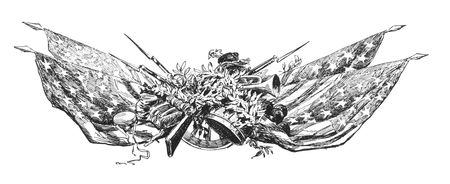

15 04
LAYAWAYS ARE WELCOME:
Need to split your order into multiple payments? No problem! A simple 20% earnest money deposit will hold your item for you.
You can then pay it off in easy installments that fit your budget.
Read Terms Here
~~~~~~~~~~

15-04-01 … Colt Army .44 Revolver With Cylinder Scene and Cartouche …
A nice looking mid-war Colt Army with very good grips that show a cartouche at the base and a lot of cylinder scene. Matching numbers 89003 throughout, giving it an 1863 production date. Wedge is an un-numbered original Colt replacement wedge. The characteristic cavalryman’s side arm. Its .44 caliber packed a big punch. Smooth grey metal overall, just a little roughness on the forward edge of the cylinder, but with scattered smoky brown over gray on the barrel. Some darker mottled colors on the frame. Cylinder retains alot of the rolled scene and very clear Colt patent markings, even the smaller line with the date, and the matching last three digits of the serial number. Sharp, legible Colt manufacturing and patent markings on the frame and barrel as well. This is a nice looking revolver, and a key piece in martial arms or cavalry collection. They were well-liked and hard-used arms. It’s tough to find them with any condition and this one is very fairly priced and would look great displayed with cavalry gear … aajjn
… $1,550.00 SOLD
Click Here to E-mail Us!
Call us @ 419-842-1863
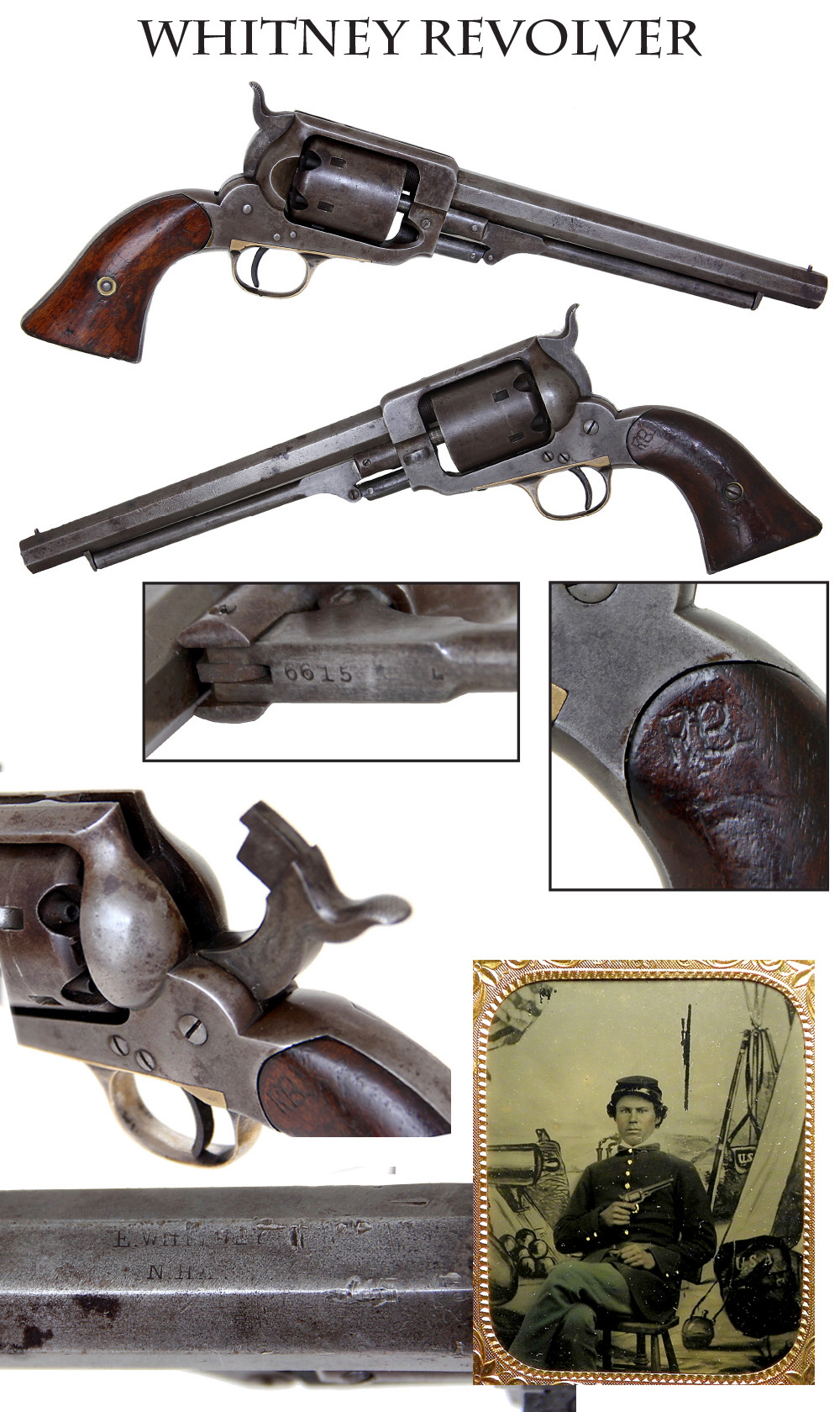
15-04-02 … Whitney .36 Caliber Revolver …
Second Model Whitney .36 revolver. A successful competitor to Colt. Much like the Remington, the Whitney was liked for its robust solid frame. Flayderman estimates half the production of the second model was purchased by the Federal government or the states for military issue. This has the ball-type loading lever latch, a serial number of 6615, six safety notches on the cylinder that place it in the Second Model-Second Type, according to Flayderman. The frame shows some very faintly cloudy gray and plum, the barrel and loading assembly more a steel gray with some darker gray spots. The metal is smooth overall, just a few dings on the barrel near the frame and an “E. Whitney / N. Haven” barrel marking that is lighter on the right. The grips have an owner’s initials, “R.B” carved in on the upper left in the curve meeting the frame, and some small bumps and crease lines. Mechanically good. One of the basic Civil War arms for the collector … aaej
… $1,495.00 SOLD
Click Here to E-mail Us!
Call us @ 419-842-1863

15-04-03 … 1st Deleware Infantry Inscribed Spencer Rifle Identified to R.S. Martin
1860 Spencer Army Rifle, serial number 28734 … Uniform color to forestock and buttstock, barrel a silver/gray, barrel bands showing plum patina. Remnants of case on the frame showing as cloudy gray mixed with some plum. Some brighter traces of case on the block. Darker plum and gray on the lock plate. Clear Spencer patent and manufacturing stamp on the upper receiver. Front and rear sights in place. Magazine tube present and draws easily. Mechanics are perfect. Sling swivels removed: bracket present on the middle band, the lower swivel now flush with the base. Wood has some nice, warm tones. Shows some chipping to forestock at the receiver. Butt stock shows a narrow crack at the wrist, as is common from the magazine tube, and a narrow crack down from the trigger plate on the underside.
These guns were issued, used, turned in and issued again to various units. This one obviously saw service. Engraved in a thin script on the right side of the frame is the name “R.S. Martin” . While there are numerous soldiers in the Union army named R. Martin, our research finds only one soldier listed as R.S. Martin and he served in the 1st Delaware Infantry which just happens to have been issued Spencer rifles! That fact is important. Only 12,000 Spencer infantry rifles were made during the Civil War. That is less than the number of Henry rifles. So there are VERY few units that were privileged to receive these “horizontal shot towers”. The first few thousand infantry Spencers went to Michigan cavalry troops. Another few thousand went to Wilder’s Lightning Brigade. Additional quantities went to Ohio Sharpshooters, Kentucky Cavalrymen, and misc infantry units. We know that some rifles in the 28,000 serial range were issued to Massachusetts troops. A September 20, 1864 circular designated the 1st Delaware and 19th Massachusetts to receive Spencer Rifles as a reward for good service. So this rifle in the 28,000 serial range makes perfect sense for our Delaware research. Robert S. Martin entered the regiment as a sergeant in company “I”. Note the letter “I” stamped into the top of the wrist on the butt stock where it joins the receiver. Again, further support for the research. The regiment served in the Army of the Potomac during 1863 and 1864 fighting at Antietam, Fredericksburg, Chancellorsville, Gettysburg, and while armed with Spencer rifles they fought at Spotsylvania, Wilderness, Cold Harbor, and Petersburg. A scarce rifle in VG condition with wonderful period inscription and interesting history
… $4,650.00 SOLD
Click Here to E-mail Us!
Call us @ 419-842-1863

15-04-04 … Metropolitan Navy Revolver With Lots of Cylinder Scene and Serial Number of 1861!
The Metropolitan Arms Company got a boost when Colt suffered a fire at the beginning of 1864. Their .36 caliber Navy revolver was pretty much a direct copy of Colt’s and they managed to produce and market about 6,000 of them from 1864 to 1866. This one has a lot of condition and a COOL serial number. Note the matching serial number 1861. Great grips and a lot of cylinder scene. The frame shows some mottled gray and plum brown patina. The barrel and loading assembly are a mix of silver gray, some very faded plum, and some darker gray spots, but just minor salt and pepper pitting at the breech. The cylinder scene is the taking of New Orleans and the cylinder engraving shows much of the scene with flags, etc. and the title: “New Orleans April 1862” stamped on the leading edge of the cylinder. Metropolitan does not seem to have garnered any military contracts, but with Colt sidelined for a while, their pistols were popular private-purchase sidearms. About half the Metro’ navies were made with plain, smooth cylinders. Those (like ours) with the battle scene on the cylinder are highly sought. Much, much, rarer than a Colt yet priced lower than a Colt. Neat with serial number 1861 … af
… $1,950.00 SOLD
Click Here to E-mail Us!
Call us @ 419-842-1863
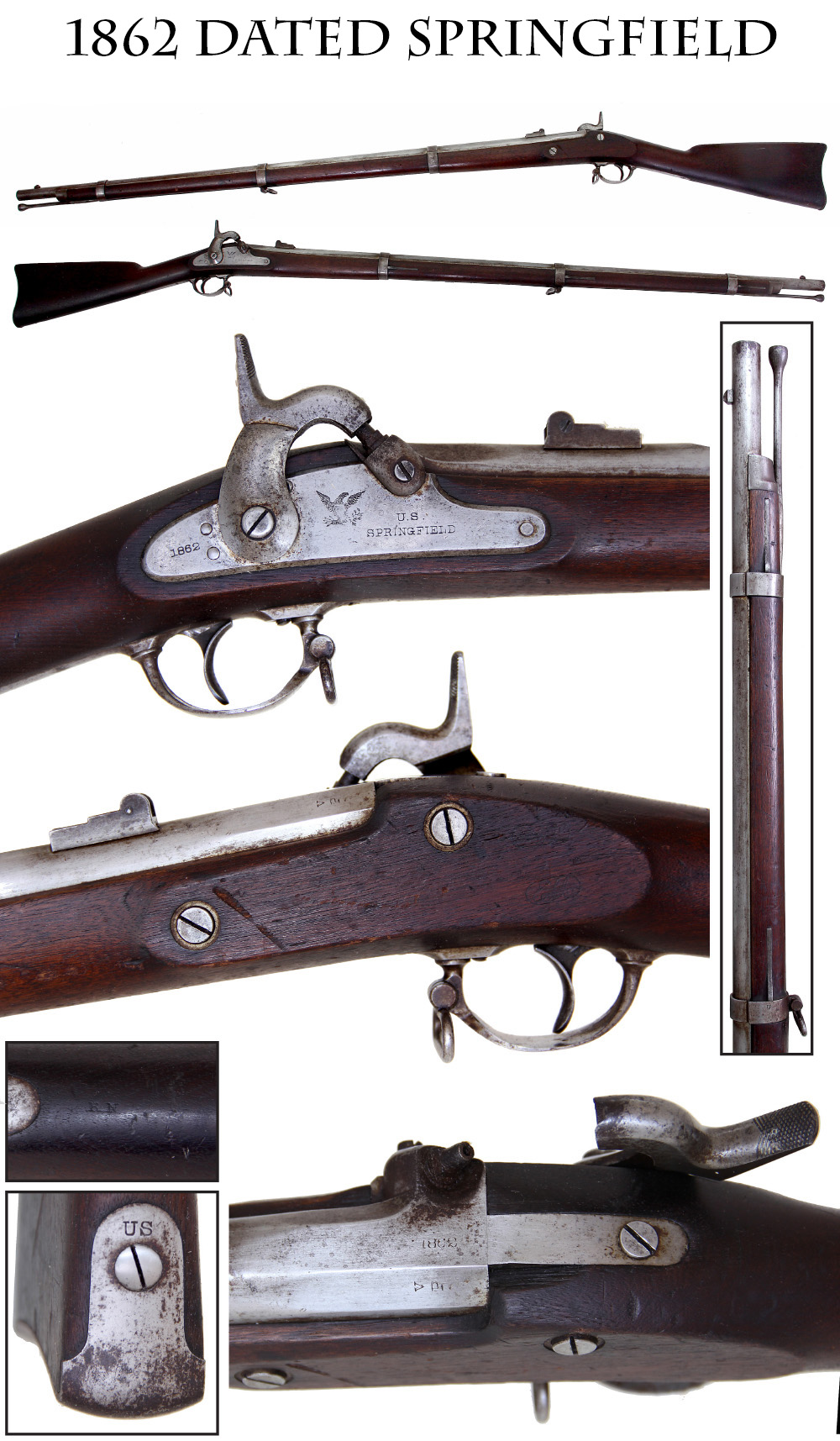
15-04-05 … Crisp 1862 Dated ’61 Springfield …
The 1861 Springfield is the most sought rifle musket in Civil War collecting. It is the quintessential long-arm of the Civil War infantryman. Here is a truly fine to near excellent condition example dated 1862, with crisp lock markings of 1862 behind the hammer, an eagle and U.S. over Springfield forward. It is 100% Springfield from muzzle to butt plate. The real-deal. Bears matching barrel date on the breech and crisp V/P/eagle proofs on the left flat. Just a little light on the barrel eagle and lower middle of the lock eagle. Metal is an even silver/gray overall with some scattered brown spots on the butt plate tang and near the nipple, bolster and hammer. Both sights are in place, as is the correct rod, all bands, springs and swivels. Crisp edges and nice medium tone to the wood. Visible cartouches on the off side including the requisite “ESA” cartouche of Springfield’s master armorer Erskine S. Allin. One or two minor dings or scrapes, a small wedge out alongside the breechplug tang, which blends in, showing it is old. These rifle muskets were in high-demand for use in the field as they came out of the arsenal and any dated 1861 or 1862 with any sort of condition is very scarce gun to find. Excellent bore. 100% original and complete. This one is a dandy and the only true ’61 Springfield I have on hand at this writing
… $2,850.00 SOLD
Click Here to E-mail Us!
Call us @ 419-842-1863
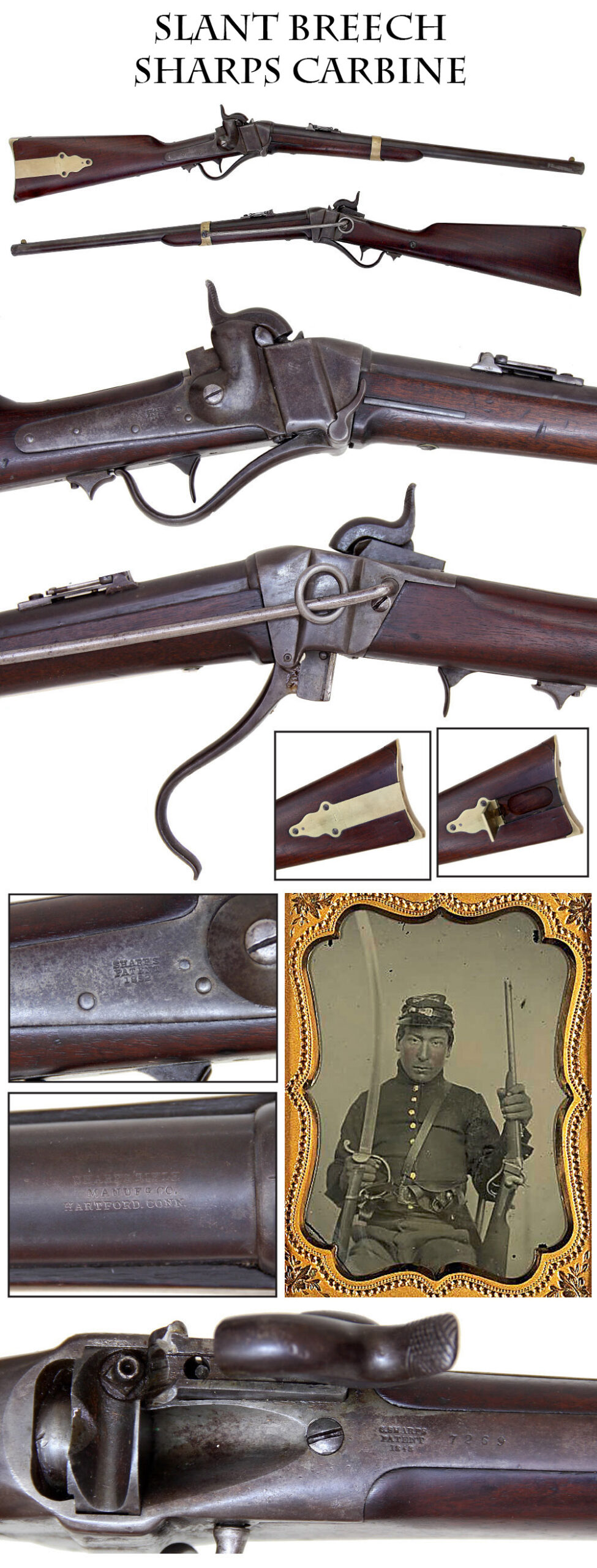
15-04-06 … Extra Fine Condition Brass Mounted 1852 Sharps Slant Breech Carbine …
A very fine condition and very scarce Sharps in strong condition. About 5,000 of this 1852 slant-breech pattern were made for Sharps by Robbins and Lawrence in Windsor, Vt., from 1855 to 1857. They saw service on the western frontier and in the early days of the Civil War. Brass mounted with a sling ring and long side bar. Fine wood, wonderful tones, with just tiny handling marks. Nice tight fit to the metal fore and aft. Correct Sharps 1852 patent stamp on the lock, Sharps Rifle manufacturing stamp on the barrel, and Sharps 1848 patent stamp on the tang, along with serial number 7269. Markings are sharp. Barrel has most of the wonderful original blue intact which is turning an attractive plum color. Both sights in place. Receiver shows some mottled gray and darker gray from dissipated case colors mixed with some brown,… hammer with more scattered surface brown on the offside. Mechanism good, brass an even light, but not bright, tone. No inspector marks or cartouches- very few were taken in by the US army at this early date. This is a classy gun and one of the prettiest of the carbines out there. I don’t think you’ll find another ’52 Sharps this nice at your next gun show
… $6,250.00
Click Here to E-mail Us!
Call us @ 419-842-1863

15-04-07 … Outstanding Western Frontier Knife …
About as interesting a frontier weapon as I have found. I can picture it hanging off the belt of a Western Frontiersman or Frontier Desperado or a Buffalo Skinner as he journeys through the Buffalo country in the 1870s. It is an absolutely 100% honest and genuine “stabbing knife” made from a Civil War socket bayonet and housed in the modified CW scabbard. The triangular blade is affixed to a stubby wooden handle which exhibits superb untouched wear and patina. It was unquestionably altered to this form shortly after the Civil War. The first six inches of blade retain the full angular configuration. The last few inches have been flattened down to more of a knife blade. The owner was likely a very poor man or at best extremely frugal. No fancy Sheffield blade for him — he could stab ya just as good with his home made sticker
… $495.00
Click Here to E-mail Us!
Call us @ 419-842-1863
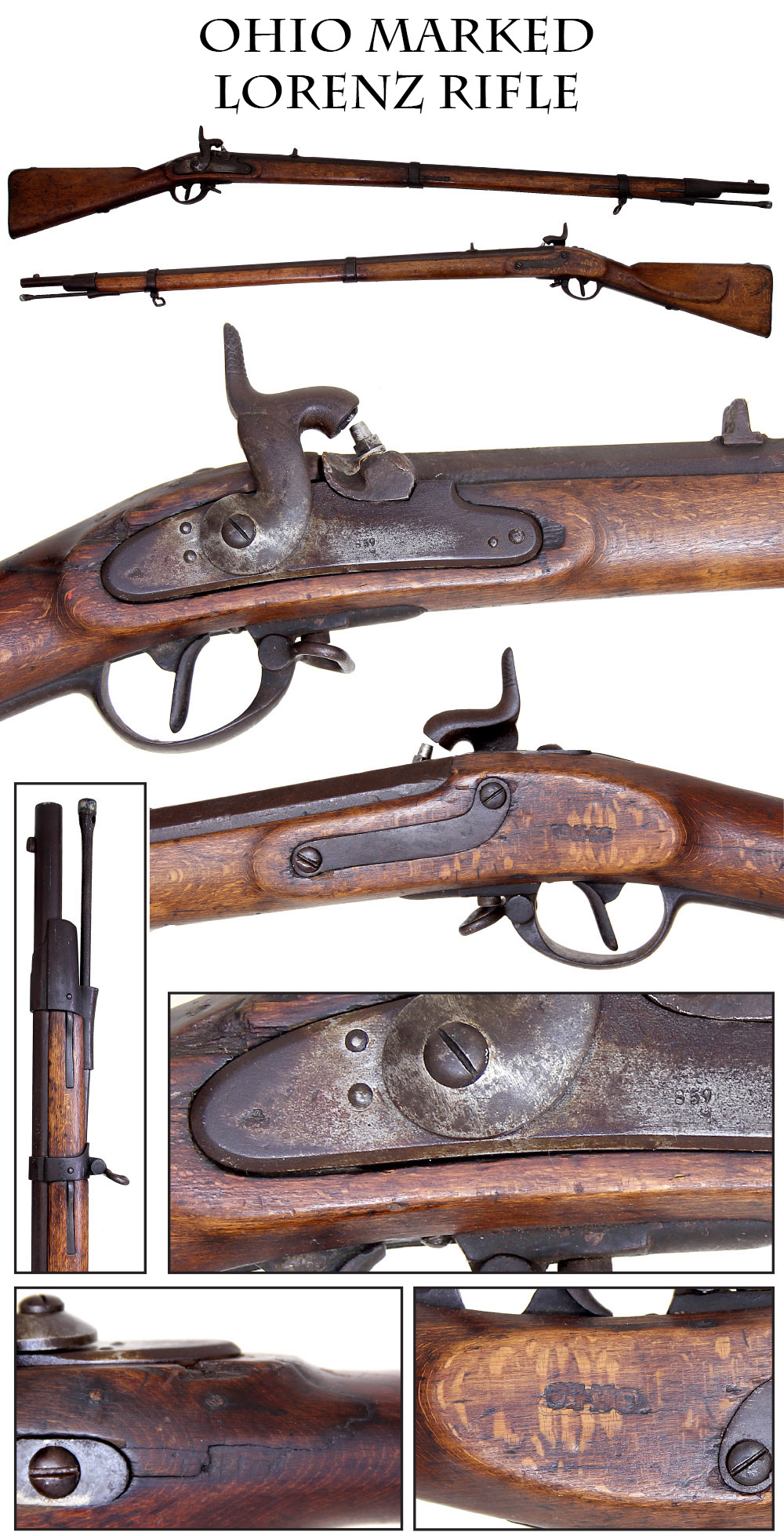
15-04-08 … Ohio Marked Austrian Lorenz …
Austrian Lorenz rifles were second only to British Enfields in the quantities brought over to this country by both sides. This one has a fixed block rear sight and the characteristic front sight mounted on an oval angled base to fix the quadrangular bayonet with a spiral groove. Clear “859” lockplate date (they used only the last three digits of the year.) Swivels, bands, and original rod with hole for torsion peg. Metal is dark overall, the barrel and bands being a plum brown, the lockplate showing some gray in the middle, but brown at the edges. Wood has good color, cheek rest is in place, but there is a minor crack from the rear of the breechplug tang, and a couple of small gouges and a narrow gap at the lockplate. Making up for this though is a very clear “OHIO” stamp in the wood opposite the wrist showing it was in that state’s hands. I’ve always liked Lorenz rifles and its nice to have one with a state affiliation
… $1,295.00
Click Here to E-mail Us!
Call us @ 419-842-1863
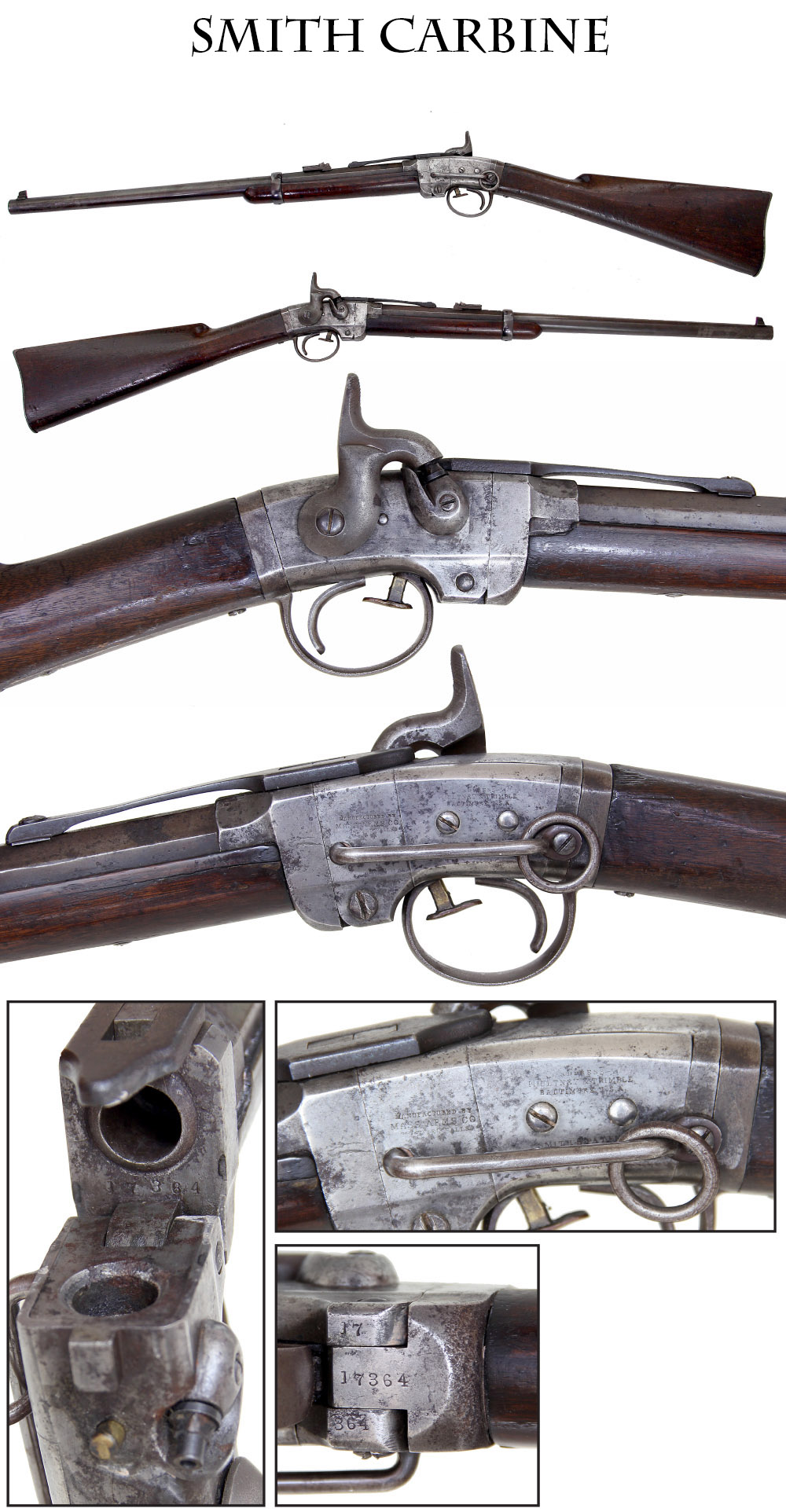
15-04-09 … Smith Carbine by the Massachussetts Arms Company …
Smiths were made by three different manufacturers. Here’s one made by the Massachusetts Arms Company and so marked on the left of the receiver forward of the Poultney and Trimble agent markings. This is a decent gun with thin blue turning brown on the barrel, barrel band, and latch. Both sights in place, though the front sight blade has been replaced. Matching serial numbers 17364. Fairly tight breech, receiver a light steel gray with some gray spotting, some faded blue turned brown on the band at the wrist. Wood is good, dark, no cartouches visible. Slight chip at upper rear of forend, right side. Decent bore. Mechanically very good. A tight solid Smith carbine for your cavalry display … abbe
… $1,495.00
Click Here to E-mail Us!
Call us @ 419-842-1863
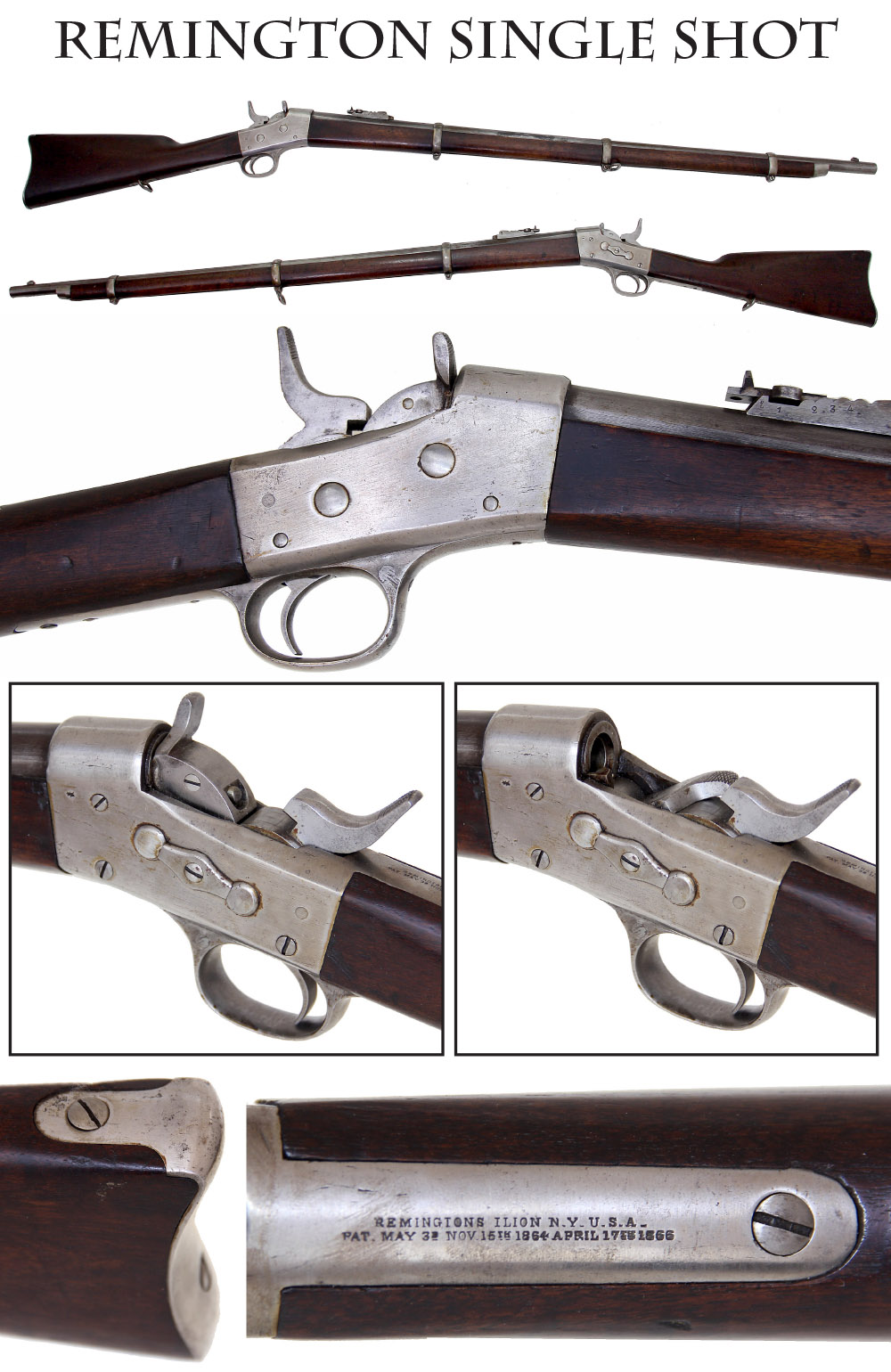
15-04-10 … Remington Rolling Block Miliitary Rifle …
Made in large numbers between 1867 and 1888, the sturdy rolling block action was a favorite with foreign militaries and National Guard units in the US. This rifle is chambered for 11.75mm x 55. Many of this caliber were sold to the Danish army. It is complete except for the missing cleaning rod. Excellent bore with deep rifling. This is an attractive example with light silver gray metal, smooth overall, and dark wood. Barrel bands, front and rear sights, swivels, in place. Two-line Remington manufacturing and patent information on the tang. Tight wood to metal fit. These guns have a lot of variations in caliber, barrel length, etc., and have become a collecting field that is generally affordable. A good solid antique Remington … zza
… $550.00 SOLD
Click Here to E-mail Us!
Call us @ 419-842-1863

15-04-11 … Two CDVS of Boy Soldiers Henry Blische and Harrison Lichtle …
These two wonderful cards circa 1865 came in the same album with period identifications on each page. The collector luckily preserved the pages with the images, but removed the cards from them and failed to note on the photos which one goes in which page. The names are clear enough: Henry Blische and Harrison Lichtle. Each is plainly young, but by no means out of the question for army service: those deemed physically fit could be enlisted with a parent’s or guardian’s permission even if underage. The photographer’s backmarks are the same, as are their uniforms and weapons (if they have not shared the rifle and gear for the sake of the photo), and they likely served in the same unit. Each holds an Enfield rifle at his side with its bayonet pointing skyward and they wear similar shortened fatigue blouses and narrow brimmed slouch hats.
Despite the New York photographer’s backmark, the German names suggest they are from Pennsylvania and Harrison Lichtle shows up quite clearly in the 213th PA, a very late war unit that did guard duty at Camp Parole in Maryland and on railroad lines near Frederick before being stationed in Washington in April, 1865. Lichtle enlisted and mustered into Co. D 2/22/65, and mustered out on 11/18/65 at Washington, DC. Like many boys of the time, he likely had a strong urge to join the army and he is likely the same Harrison Lichtly, who enlisted in Co. I of the 42nd Pennsylvania Emergency Militia on 7/6/63. This was a regiment recruited during the Gettysburg campaign to serve ninety days unless sooner discharged. They did some marching with the hope they might trouble Lee’s retreat, but the end of the campaign led to their muster out 8/12/63, without seeing any fighting, which was probably a lucky thing for an inexperienced regiment against Lee’s veterans.
Henry Blische, however, has not been easy to find and may lurk in the records under an assumed name, particularly if he enlisted under a false statement of age or with forged parental permission. We have tried a number of variations of the name, and have a few candidates, but none so far with sufficient evidence where we can say with certainty that it is him . He was likely also in the 42nd Emergency Militia or the 213th Pa. In any case, this is a pair of sharp photos of boy soldiers who were actually in the ranks. I note that Lichtle seems to have the name “Tony” written at the bottom of the page. This might actually be “Pony,” a nickname used during the war for short soldiers. Price for the pair
… $295.00 SOLD
Click Here to E-mail Us!
Call us @ 419-842-1863
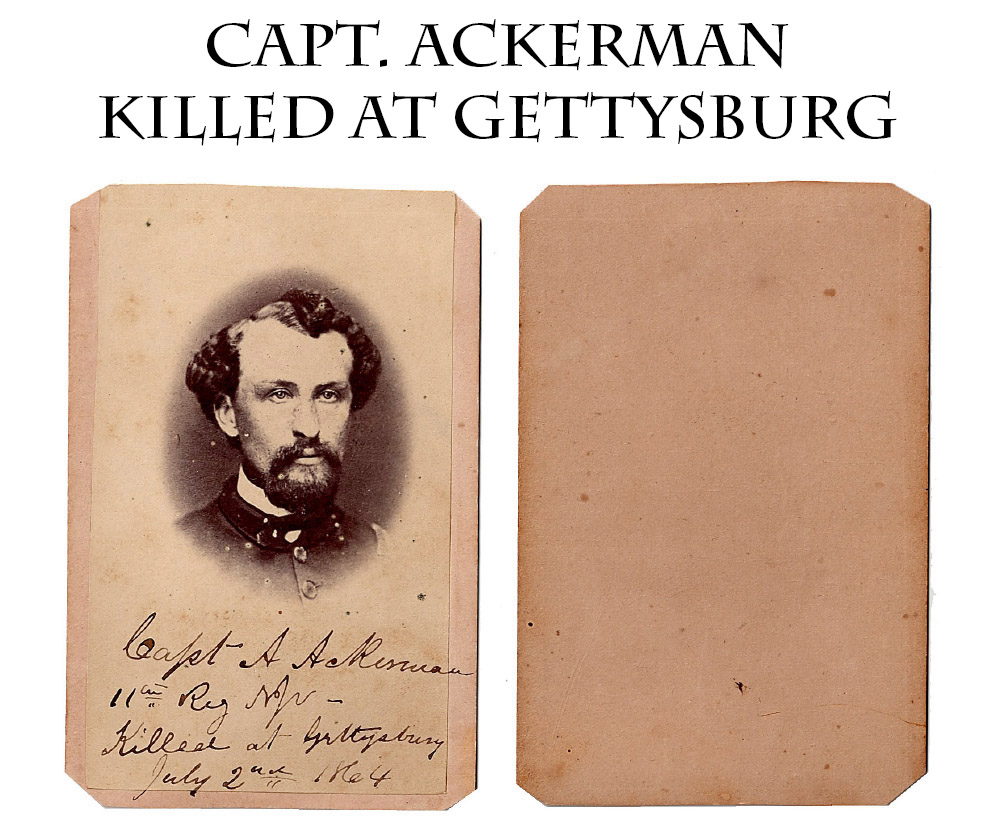
15-04-12 … CDV of Captain Andrew H. Ackerman, Company A, 11th New Jersey, Killed in Action at Gettysburg July 2, 1863 …
Vignetted bust bust view of bearded officer bearing a period pen identification at bottom reading: “Capt. A Ackerman / 11th Reg NJV/ Killed at Gettysburg / July 2nd 1864.” The writer made a slip of the pen in dating the battle to 1864, but there is no doubt about the identification. Andrew H. Ackerman first served in the 2nd New Jersey, enlisting as a private and mustering into Co. I the same day. He was discharged for promotion on 7/21/62 and commissioned as Captain of Co. A of the 11th New Jersey on 8/18/62. He was killed in action at Gettysburg on 7/2/63 when the regiment took part in desperate attempts of the Third Corps to stem Confederate attacks along the Emmitsburg Road. During Ackerman’s service the 2nd saw action in the Peninsular Campaign, losing 30 men killed at Gaines Mill, and the 11th fought at Fredericksburg and at Chancellorsville, where it lost 23 killed in action. Ackerman’s fall on July 2 is specifically mentioned in Adjutant Schoonover’s report of the battle in the official records: “A few minutes previous to the command “Fire!” spoken of in the accompanying report, Maj. Kearny, then standing near me on the left of the line, was struck by a Minie ball in the knee, and immediately carried to the rear… word was conveyed to me that both Capt.’s Martin and Logan were wounded and being carried to the rear. A moment later, and Capt. Ackerman fell dead by my side…. By this time Capt. Lloyd had also been wounded, and Capt. Dunning being absent in assisting the colonel to the rear, I assumed command of the regiment. The fire of the enemy was at this time perfectly terrific; men were falling on every side. It seemed as if but a few minutes could elapse before the entire line would be shot down, yet the galling fire was returned with equal vigor. Slowly and stubbornly the regiment fell back, keeping up a continual fire upon the line of the enemy, which was still advancing, until more than half of its number had been killed and wounded.” The inscription is worth the price of admission … zabj
… $495.00 SOLD
Click Here to E-mail Us!
Call us @ 419-842-1863

15-04-13 … 1790 TO 1820 Period Cartridge Box and Waist Belt Remains …
Wide leather waist belt with two narrow fastening straps typical of the period, carrying a rectangular cartridge box consisting of a heavy leather box, cover, and belt loops holding 24 large bore tin cartridge tubes. Worn, aged, condition but solid. Belt lacks a few inches in length. During the Federal period, militia service was required of adult male citizens and they were required to appear at musters and drills properly armed and equipped. The 24-round cartridge box was part of their standard gear and appears in a number of different forms. Those with tin tube were likely favored for their lightness by those who could afford them. This one is in good condition and solid. The latch tab on the inside of the cover is gone, but the small square fastening buckle is still in place on the bottom of the box. One of the narrow fastening straps on the belt is present, but the other one and the two small buckles that would have secured them are long gone. Nevertheless, the box displays very well and is scarce even this complete. It displays wonderfullywith other early Federal period artifacts or in a collection of early US militia arms and accouterments, which are varied and colorful. Nearly 200 years old and still affordable
… $275.00 SOLD
Click Here to E-mail Us!
Call us @ 419-842-1863

15-04-14 … Germanic or French Light Cavalry Saber and Scabbard CA. 1800-1825 …
A fine early iron-mounted saber complete with scabbard. Nice full leather wrapped grip with binding wire in place. Bird’s head pommel. Three branch iron guard with full pointed oval langets. Singe-wide-fuller blade with clipped point. Blade is plain, not etched, bright for the most part, mixed with some scattered gray spots, but with a good edge and point. Steel scabbard has a darker patina of gray mixed with brown, matching the hilt and showing they have been together and sheathed forever. Carrying rings and drag in place. A nice saber dating from the early 19th century, somewhat French looking in the langets, but the iron mounting seems rather Germanic. A lot of saber for very little money
… $595.00
Click Here to E-mail Us!
Call us @ 419-842-1863

15-04-15 … Merrill Rifle Serial Number 9605 …
I have been lucky enough to pull several of these scarce rifles from a long-time collector who specialized in them. They are one of the scarcest Civil War breech loading rifles and one with a known history of use in the field. Only 800 or so were made by James H. Merrill in Baltimore using the same system he patented for his carbines, and the U.S. government bought 770 of them, issuing them to the 21st Indiana, parts of the 7th and 10th Michigan, 4th Arkansas, and the 1st Massachusetts. Very good edges to the light color walnut stock, being positively sharp at the rear point of the lockplate apron, and showing a sharp inspector cartouche on the offside. Brass bands, sideplate, nosecap, buttplate and patchbox show a medium-light (but not bright) patina with some darker spots. Clear Merrill manufacturing and patent information on the lock, matching serial number 9605 on the plate and loading assembly, assembly number “0/33” also on the lever. Legible Merrill patent stamping on the lever top, a little light, mixed in some darker gray spots. Barrel has a beautiful mellow thin blue turning plum brown. Receiver and loading assembly show mottled gray and purple remnants of case hardening. Sights, swivels and original button-head cleaning rod in place. Nipple good, not battered down. Rear sight has the leaves in place and shows blue/plum matching the barrel. The only defect is the one common to Merrills that have seen use: a minor horizontal crack running straight back in the wrist from the rear lock screw to the base of the receiver tang. This is commonly seen and is the result of the Merrill breech mechanism weakening the wrist. The wood is stable, and it is such a common attribute of Merrills that I would not give it a second thought, Other than that, just a few minor handling dings. Despite the quantity of these that I have been able to offer recently, this is truly a very rare breech-loading infantry rifle and one especially desirable because it was actually used in the field. The fact that I was able to purchase a lifetime collection might make them “seem” common… but they are not. When mine are gone… they’re gone
… $3,250.00 SOLD
Click Here to E-mail Us!
Call us @ 419-842-1863

15-04-16 … William S. Provost 11th New Jersey Wounded in Action at Gettysburg …
Another wonderful Gettysburg related CDV from a New Jersey collection I am working through. Vignetted bust shot by Clark of New Brunswick, NJ, signed in ink on reverse: “Yours Truly / W. S. Provost / Lieut. V.R.C” … Provost (1837-1884) is another member of the 11th New Jersey who had hard battle experience. He enlisted in the 1st NJ on 5/23/61 as a Sergeant and mustered into Co. G on 5/28/61. He made Sergeant Major of the regiment 9/21/61. During his service the regiment saw hard service on the Peninsula, losing 32 men at Gaines Mill. Provost was discharged for promotion 7/15/62 and commissioned the same day as 2nd Lieutenant of Co. K of the 11th NJ. He made 1st Lt 5/4/63 and went into Co. B. At Gettysburg in the fierce fighting along the Emmitsburg Road on July 2 he was severely wounded. At the same time on July 2, Col. McAllister was seriously wounded, Capts. Kearney, Martin, Logan and Ackerman were killed, and nearly all the remaining officers were wounded, while the ranks were terribly thinned by the fire of the Confederates the losses in the regiment being 3 commissioned officers killed and 10 wounded, 21 enlisted men killed and 120 wounded, making a total of 154.
Once he had somewhat recovered Provost joined the Veteran Reserve Corps, joining Co. G of the 24th Regiment, which became the 99th Company of the 2nd Battalion, and lastly transferred to the 11th VRC. He was breveted Captain as of March 13, 1865, and finally discharged 6/30/66. With such experienced and devoted soldiers it is not surprising the 11th put up such a fight on July 2, 1863. Another member of a hard-fighting unit on a critical day in the nation’s history … zabj
… $395.00 SOLD
Click Here to E-mail Us!
Call us @ 419-842-1863

15-04-17 Crisp Photo of Major General Sheridan …
Anthony backmarked “from life” Brady photo of the famous general. (Brady gave Anthony some publishing rights to settle a debt,) Three-quarter seated view, hand on hip, wearing his major general’s frock coat and his iconic narrow-brim flat topped slouch hat in the studio. Period pencil identification across the bottom front of the card. Sheridan needs no introduction to a Civil War collector. He made his reputation as a fighter out west and Grant put him in charge of the Federal cavalry and let him loose to do some damage. He led his own army in the Shenandoah, and made reputation that was only outshone by Grant and Sherman. Meade was annoyed by his impatience to get at and beat the enemy and reported it to Grant, who advised him Sheridan generally knew what he was talking about and to get out of the way and let him do it. A strong photo of a general not to be trifled with. Classic Phil Sheridan
… $250.00 SOLD
Click Here to E-mail Us!
Call us @ 419-842-1863
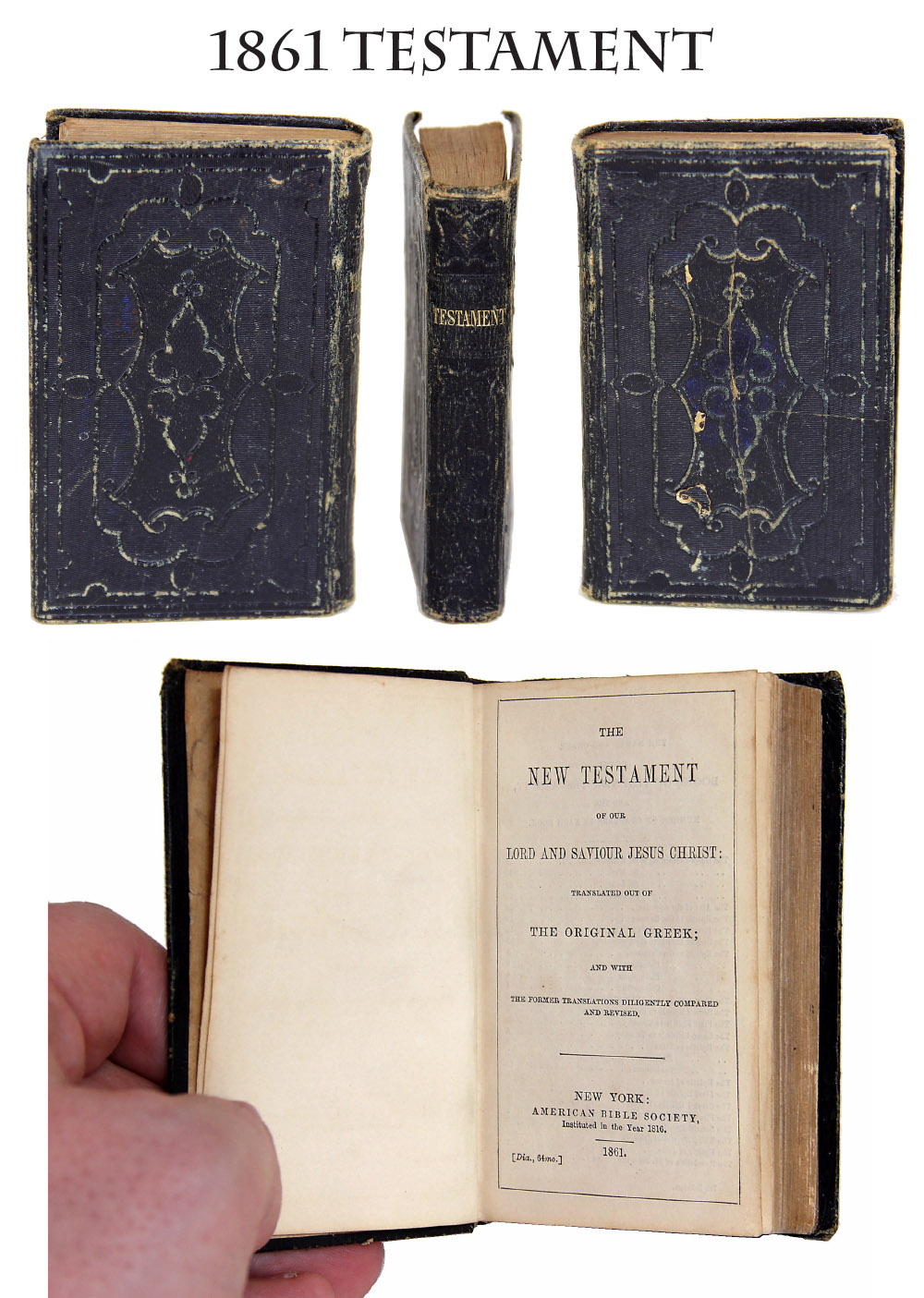
15-04-18 … 1861 Dated Pocket Bible …
Leather bound pocket-sized New Testament published by the American Bible Society in 1861. Excellent condition, just minor scuffs to the cover. Thousands of these were handed out to newly enlisted soldiers and they became part of many soldiers’s personal effects on the march and in camp. A key piece in a display of soldiers’ personal gear
… $95.00 SOLD
Click Here to E-mail Us!
Call us @ 419-842-1863

15-04-19 … A Proud Cavalryman Displays the Tools of the Trade …
Sixth plate outdoor tintype of bearded yankee cavalryman posed in front of a plain backdrop showing off his unsheathed saber and making sure the folks at home could see his new pistol by shoving it through the front of his belt. You can see this fellow is holding his shoulders back and doing his best to assume the position of a soldier for the camera. The photographer touched up the brass in the photo with some gilt highlights but weaponry comes through and our fellow has pushed his forage cap back on his head so there will be no mistaking him. His cheeks are very lightly tinted red., chinstrap buckle, saber hilt, buttons and belt plate gilt. Full “leatherette” case with impressed floral and geometric motifs, red velvet facing pad with impressed designs as well. A nice presentation
… $275.00 SOLD
Click Here to E-mail Us!
Call us @ 419-842-1863

15-04-20 … Remington Single Action 38 Caliber Rimfire Belt Revolver:
One of the scarcer Remington revolvers of the era. These tight little belt models are slightly smaller than the Navy models and have a 6.5 inch octagon barrel. They were made 1863 to 1873 in percussion and 1873 and later in cartridge configuration… which makes this perfect for display with Reconstruction antiques, Cowboy and Outlaw items, or Western Expansion artifacts. Overall NRA “Very Good” condition. 100% original and complete. Mechanically perfect. Good markings. Great grips. Has proper blade style front sight. Very scarce with less than 3,000 produced and far fewer converted to, or made as, cartridge guns and still surviving in nice shape. Compare this price with the prices for the nearly 150,000 Army and Navy revolvers produced ! One heck of a bang for the buck
… $1.195.00 SOLD
Click Here to E-mail Us!
Call us @ 419-842-1863
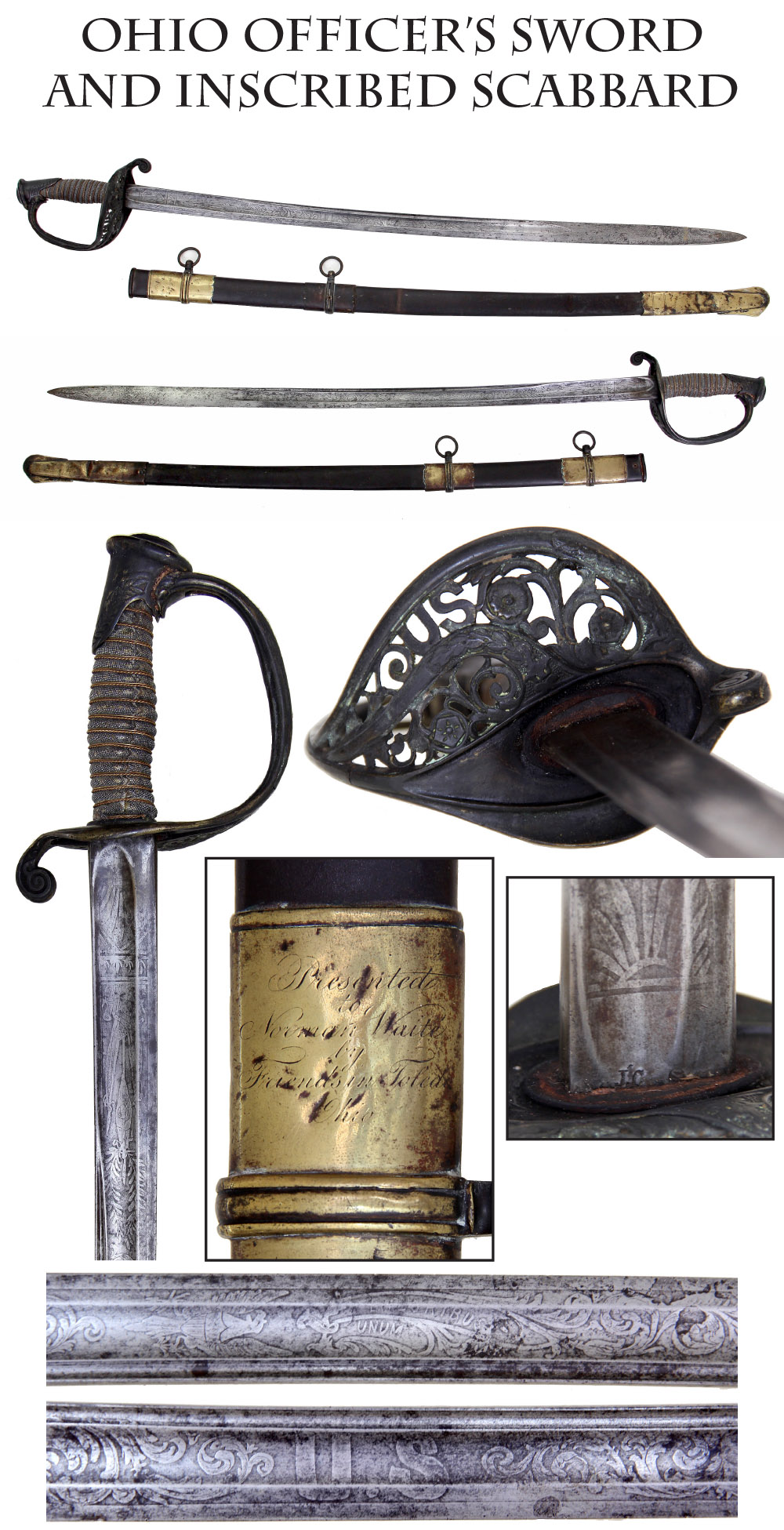
15-04-21 … A Fighting Ohio Officer’s Presentation Staff & Field Officer’s Sword …
Nice identified, inscribed and presented, untouched example of this regulation sword. Unstopped fuller, small “J.C.” and a cartouche low down on the ricasso partly hidden by the leather washer, indicating a typical German-made import that was sold by many military goods dealers and outfitters. Very good sharkskin wrap and triple-wire on the grip, just a few wear spots. Brass hilt shows nice untouched age patina on the guard, floral motifs and inset “US” in the guard. Blade is dull silver mixed with gray, but with very clear etching of floral motifs on both sides, with a U.S. on one side and a vertically oriented eagle with “E Pluribus Unum” above is two rather leaf-like splays. The scabbard is a very practical blued iron with brass mounts: throat, middle band, rings, and drag. Some darkening to the mounts and some dents to the brass drag and upper mount. The family began cleaning the brass mounts then quit the attempt. The upper mount is inscribed: ”
Presented / to / Norman Waite / by / Friends in Toledo / Ohio
”
Waite had an active record and his promotions indicate he was a competent soldier. He enlisted at age 27 on 8/10/62 as the Sergeant Major in the 100th Ohio (A local Toledo regiment.) and was mustered in on 9/1/62. He made 2nd Lt. 11/23/62 (Co. G); 1st Lt 2/17/64 (Co. E), Adjutant 12/1/64 and then was discharged for promotion to Major of the 189th Ohio on 3/10/65, which reported to General Thomas and served at Nashville, Murfreesboro and Tullahoma. Waite was discharged 9/28/65. A native of Connecticut, he returned to New England after the war and was a member of a Brighton, Mass., GAR post. He died in 1907. The 100th Ohio spent most of its service in the 23rd Corps of the Army and Department of Ohio. It first served in Kentucky for a year before going to Tennessee and taking part in the defense of Knoxville. It participated in the Atlanta Campaign, and was present “at almost every battle from Rocky Face Ridge to Atlanta, taking casualties at Resaca, Dallas, Kennesaw, Atlanta, Utoy Creek, Columbia, Frankin and elsewhere. In the attack of 8/8/64 at Atlanta it lost 103 out of 300 men, of whom 36 were killed in action and 8 were mortally wounded. The regiment’s colors were so tattered from hard service and battle damage that Waite wrote a letter to the Toledo newspaper published in April, 1864, asking for the donation of a new stand of colors:
Sept. 8, 1863, 300 of the Regiment met 1,200 of the enemy and fought them from 9 to 11:30 A.M., and repulsed them, and then fell back six miles, and from 1:30 till 5 P.M. fought 2,100 Rebels with four cannon, our boys having no artillery-holding them until their last cartridge was fired, and then retiring into log stockades, which the enemy soon knocked down over their heads, and only surrendered when overpowered by seven to one. We have lost one flag and have one-half of the other, filled with bullet-holes, the balance having been shot away by a shell from the enemy’s guns. Will not the citizens of Lucas County see that this Regiment — true to its country — true to its State, and an honor to this District-is furnished with a new stand of colors?
Funds for new colors were sent to the regiment which later carried them at Franklin, of which Waite also gave an account: Colonel E.L. Hayes ordered the Color-Bearer (Byron C. Baldwin, Co. A) to advance and place his colors in the works, which he did, and the works were ours again. It was nearly dark, and they had charged at six different times, and we fought nearly the whole time until 10 P.M. Capt. W.W. Hunt, Acting Major, fought nobly. About 7 o’clock we missed him, and found him dead near the front works. Lieut. Milton A. Brown was on the skirmish line and was wounded as it was falling back, but gained our works, and while cheering on our men was shot dead. Color-Sergeant Baldwin had the flag presented to us by the citizens of Toledo. The upper part of the staff was broken off by a bullet, and the lower half gone. While thus carrying the colors he was shot, when he deliberately wrapped the flag around him and died-his life-blood saturating the folds of the flag. In less than 48 hours the Regiment fought in two hard battles, and marched over 40 miles, besides building a line of works. We went into the fight with 250 men and lost 62 in killed, wounded and missing.
The flag was later returned to the Toledo Board of Trade with the request that it be preserved in honor of the color-bearer who had died carrying it. The regiment also took part in the fighting at Nashville, and then moved to North Carolina. During its service it lost 65 men killed in action and 27 mortally wounded, as well as 142 wounded, and more who died of disease or in Confederate prisons. An sword carried by an officer who saw a lot of action in some very hard-fought battles in the west.
… $2,650.00 SOLD
Click Here to E-mail Us!
Call us @ 419-842-1863

15-04-22 …
15-01-04 … 7 Eagle-A Buttons …
Early two-piece 1840s – Mexican War era artillery buttons. Each has a simple back mark of stars in a circle around the shank. Prior to the Civil War buttons with branch-of-service letters in the shield were used for both officers and enlisted men. By the time of theCivil War “general service” buttons (plain eagle buttons) were the norm for enlisted ranks, with the branch of service lettered buttons being worn mainly by officers. I have seven identical coat size “Eagle A” examples priced each at
… $69.00 or if the first caller wants all seven I will sell the lot for $375.00
Click Here to E-mail Us!
Call us @ 419-842-1863

15-04-23 … Beautiful Eagle Motif Tongue Wreath 2-Piece Interlocking Buckle:
My favorite form of waist belt plate is this interlocking tongue and wreath design. This specimen is absolutely stunning in terms of die work and condition. The federal eagle is on a lined field and surrounded by stars. The wreath is a finely executed laurel wreath design Circa 1845 and perfect for display with early war US or Confederate effects. Batch number “56” marking is legible on both parts. Among the best condition examples I have owned
… $1,150.00 SOLD
Click Here to E-mail Us!
Call us @ 419-842-1863

15-04-24 … Superb Blacksmith Made Bowie Knife …
A wonderful home made knife from the days of the western frontier. Very large measuring 13 inches overall. Grips are polished horn with some insect damage. The blade is grey steel and measures 8+ inches in length. The sheath – scabbard is ingenious. It incorporates a standard style sheath but has attached to it by leather thongs, a sliding pommel cover which secures the knife in place with the cover is attached. In addition to this the thongs continue upward for securing to the wearer’s belt. If you have this knife on your person and it has the securing cap in place — you cannot lose it even if you fall from your horse or stumble while running. I have never seen another which is why I bought this one when a local antique dealer showed it to me. Overall excellent with a couple repairs to broken thongs
… $450.00 SOLD
Click Here to E-mail Us!
Call us @ 419-842-1863
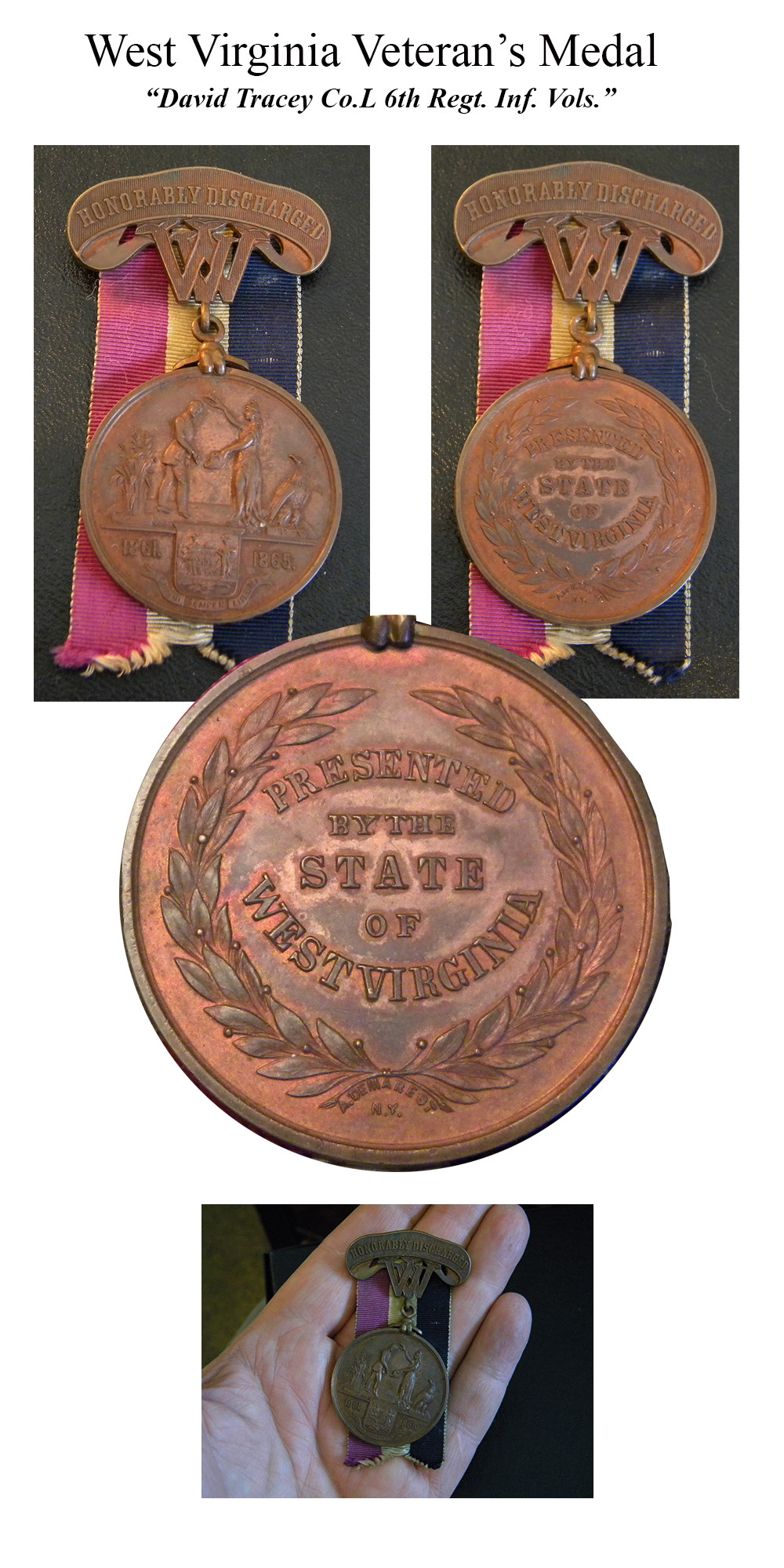
15-04-25 … West Virginia Veteran’s Medal …
“David Tracey Co. L 6th Regt. Inf. Vols.” This the “Honorably Discharged” version of this medal that was presented by the state to her veterans or their survivors. The arced motto at top has an open-work WV beneath it suspending the planchet showing Columbia crowning a soldier with a victory wreath, the state seal beneath, flanked by the dates 1861 and 1865, and the reverse with the words “Presented by the State of West Virginia” surrounded by a wreath with the soldiers name impressed on the edge: “David Tracey Co. L 6th Regt. Inf. Vols.” Tracy was an early-war enlistee, signing up in Co. L of the 6th on 8/1/61. The regiment was recruited mainly to guard the lines of the Baltimore and Ohio Railroad, and served by company in different locations as was necessary. In 1863 and 1864 they fought a number of small engagements. CWdata lists some of Co. L participating in the fight at New Creek in 1864. The regiment lost 8 men killed or mortally wounded during its service and mustered out 6/10/65. A top notch example of this attractive early medal
… $425.00 SOLD
Click Here to E-mail Us!
Call us @ 419-842-1863

15-04-26 … Civil War Era Fife …
Classic rosewood fife with nickel silver end ferrules. Likely from the GAR era. Fine for display or can still be played …ej-chu
… $95.00 SOLD
Click Here to E-mail Us!
Call us @ 419-842-1863

15-04-27 … Confederate Infantry Cartridge Box With Historical Note: …
These Johnny Reb accoutrements have ALWAYS been rare. This one is a “no-doubt-about-it” rebel box. It is of totally sewn construction. The belt loops do not pass through the back of the box to the interior as seen on Yankee boxes, but are instead folded over at the top and secured in place by zinc rivets top and bottom. The closing finial is a ferrous metal button. The sides show the classic southern workmanship of pin-hole marks where the leather was pinned in place while being stitched together. Union leather goods were finished with a starburst punch which filled in the pin-holes after stitching. The rebs didn’t bother with that last step of starburst punching. The interior dimensions of the box itself are 6.75 x 1.3 inches. Exterior dimensions of the front flap are 7.75 x 6.25 inches. The interior has an implement pouch and interior flap. The two tin liners are still in place inside the box. Affixed to the outer flap is an ancient typed note which reads…. “C O N F E D E R A T E B O X —- ???? A T L A N T A —-” Overall VG condition. Lacks only the leather closing tap. Front flap of box starting to weaken at the rear hinge area
… $3,450.00
Click Here to E-mail Us!
Call us @ 419-842-1863

15-04-28 … CDV of Rhode Island Surgeon …
Dr. Howard Williams King (1824-1875) was born in Rhode Island, the son and father of prominent physicians. He received his medical degree from Bowdoin College, practiced in Greenville, RI., and on 6/24/62, enlisted and was commissioned Assistant Surgeon in the 7th Squadron Rhode Island Cavalry, a two company organization mustered into service for three months under Major A.W. Corliss. King joined the squadron in August near Winchester, Va. With the defeat of Pope’s army at Second Manassas the squadron agreed to remain in service until Lee was driven back. They took part in the withdrawal of forces to Harpers Ferry, where they were part of the force who escaped capture by making their way through enemy lines, actually seizing a Confederate wagon train before they joined McClellan at Antietam. There they were assigned to Franklin’s Division, but not called into action. The regiment reached home on 9/26/62 and King mustered out 10/2/62. Even before the 7th Squadron mustered out, Corliss received orders from the War Department to recruit a battalion of the Second Rhode Island Cavalry in August. On 11/15/62 a full regiment of three battalions was authorized, Corliss promoted to Lt. Colonel and King once again shows up on Corliss’s staff as Assistant Surgeon.
The regiment was ordered to New Orleans as part of the Army and Department of the Gulf, taking part in Gen. Banks’s first advance against Port Hudson, the Bayou Teche expedition, the battles of Bisland and Franklin, the expedition to Alexandria and siege of Port Hudson, and on 6/20/63 they were engaged in a fierce little fight while protecting a forage train. Reduced by losses to a single battalion of four companies they were ordered consolidated with the 1st Louisiana cavalry and the field and staff, including King, resigned and were honorably discharged. King is listed in the regimental history in Rhode Island in the Rebellion as full Surgeon, the uniform in which he is photographed. The records are unclear when he received the promotion, but it likely dates to 4/23/63, when the regimental Hospital Steward was promoted to Assistant Surgeon. The previous owner noted that King served from Bull Run through Gettysburg. I am not sure where he got that data. I am discounting it. After leaving the 2nd RI Cavalry, King was elected Surgeon General of the RI Militia in 1864, and may have done some work as a contract surgeon as well. The 1866 report of the Rhode Island Adjutant General records payment to him of $304.55 for “attendance on soldiers, freedmen, &c” and reference is also made in a state resolution in 1872 of an allowance to him, “for services rendered disabled soldiers.” He returned to medical practice after the war, was President of the Providence Medical Association in 1868 and Vice-President of the RI Medical Association in 1874. His health failing, he traveled to Europe in hopes of a recovery, but died in 1875 and was buried with military honors. Historical CDV of a big-wig Rhode Island doctor
… $250.00
Click Here to E-mail Us!
Call us @ 419-842-1863

15-04-29 … Colt 1849 Pocket Revolver w/ 5 Inch Barrel:
This pocket has a lot of appeal and very attractive patina. The barrel assembly has faded from blue to plum brown on the barrel with bright metal just showing through on some of the edges from rubbing. Clear Colt barrel legend. Good wood to metal fit, with some dings at the uppermost portion of the grips on the left and a little farther down on the right. Varnish is present and they are generally good. Matching serial number 233269, making this a good mid-Civil War 1863 manufactured gun perfect for an officers set or early western collection. Clear cylinder markings and number, but no scene to speak of. Mechanically very good. The only thing I don’t like is that someone, decades ago, used a large brass screw on the bottom of the buttstrap that should be replaced. A very handsome Colt that I obtained locally and have priced very affordably at
… $750.00 SOLD
Click Here to E-mail Us!
Call us @ 419-842-1863
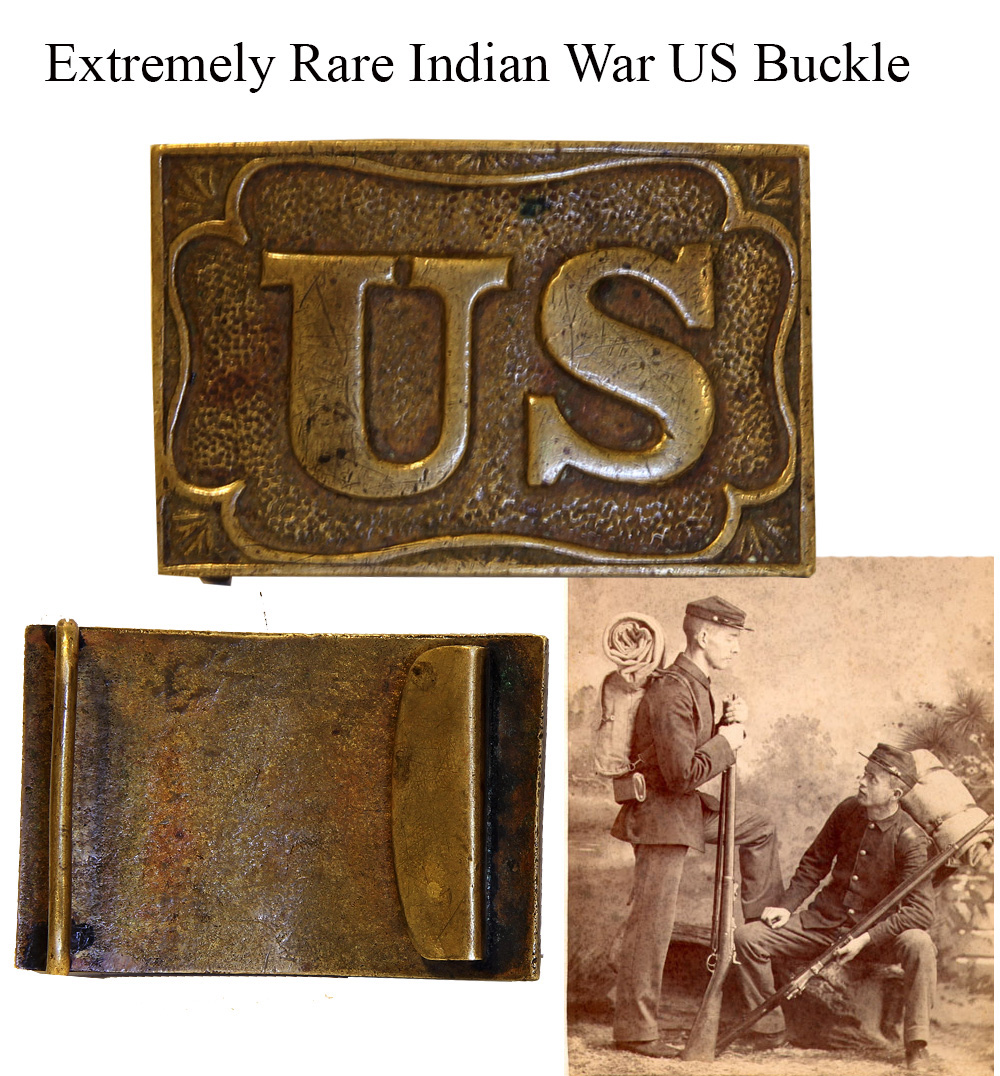
15-04-30 … Extremely Rare Indian War US Buckle …
Very unusual non-regulation belt plate about 1872 to 1885 with a block “US” on a stippled background surrounded by a raised curved border with a small fan of leaves in each corner between the raised inner border and the edges of the rectangular plate. This is about 15% smaller than the standard Indian War rectangular US plates. Also 15% smaller than Civil War cavalry eagle buckles. Wide tongue for fastening and a raised bar on the reverse for looping the waist belt through. We see some interesting variations for Mills pistol belts, etc., but this plate is truly unique in my experience. About as appealing an Indian War buckle as I have ever seen. I fell in love with it when I found it. I am guessing at the value
… $375.00 SOLD
Click Here to E-mail Us!
Call us @ 419-842-1863
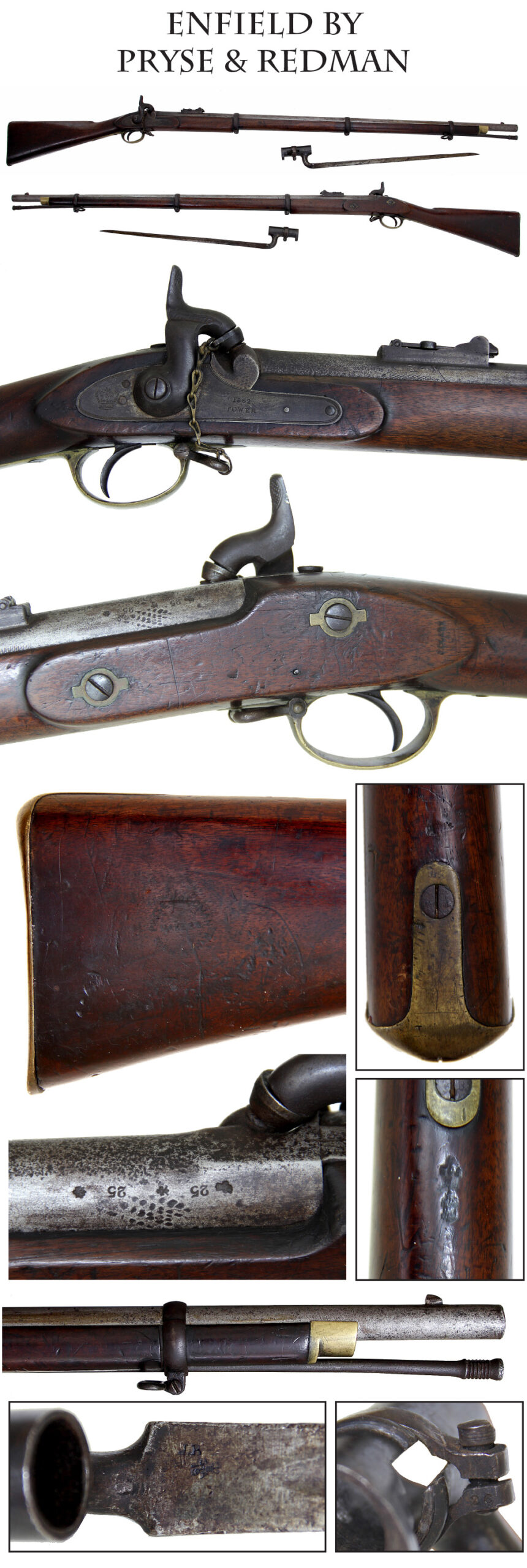
15-04-31 … P53 Enfield Rifle Musket by Pryse and Redman w/ Bayonet …
Birmingham gun trade Enfields have taken off recently since collectors have come to realize how many made their way into Confederate hands through various channels. Ours shows a silvery gray barrel with darker traces of blue and case color on the lockplate that is clearly marked 1862 over Tower forward of the hammer and with a crown behind it. It has nice original color on the rear sight and bands. Correct ramrod in place. Both swivels present. Nipple protector and chain are present. Both sights in place. Decent rifled bore. Some scattered pitting and a vise marks near the breech. The 25/25 gauge markings (indicate 577 caliber) and Birmingham view and proof marks are nice and clear. Good edges to the wood around the lock, on the offside, and in general, just the usual handling marks and light dings. Pryse and Redman circular maker’s stamp plainly visible on the butt flat, smaller stamp that appears to read “J. Clark” on the flat opposite the lock, and two cartouches in the wood below the triggerguard tang that I cannot make out. Nice mellow tones to the brass. Comes with an Enfield bayonet that fits (not an easy thing since there was so much hand-fitting with these.) A classic Civil War arm with some good potential for having seen Confederate use with the bayonet
… $1,650.00 SOLD
Click Here to E-mail Us!
Call us @ 419-842-1863
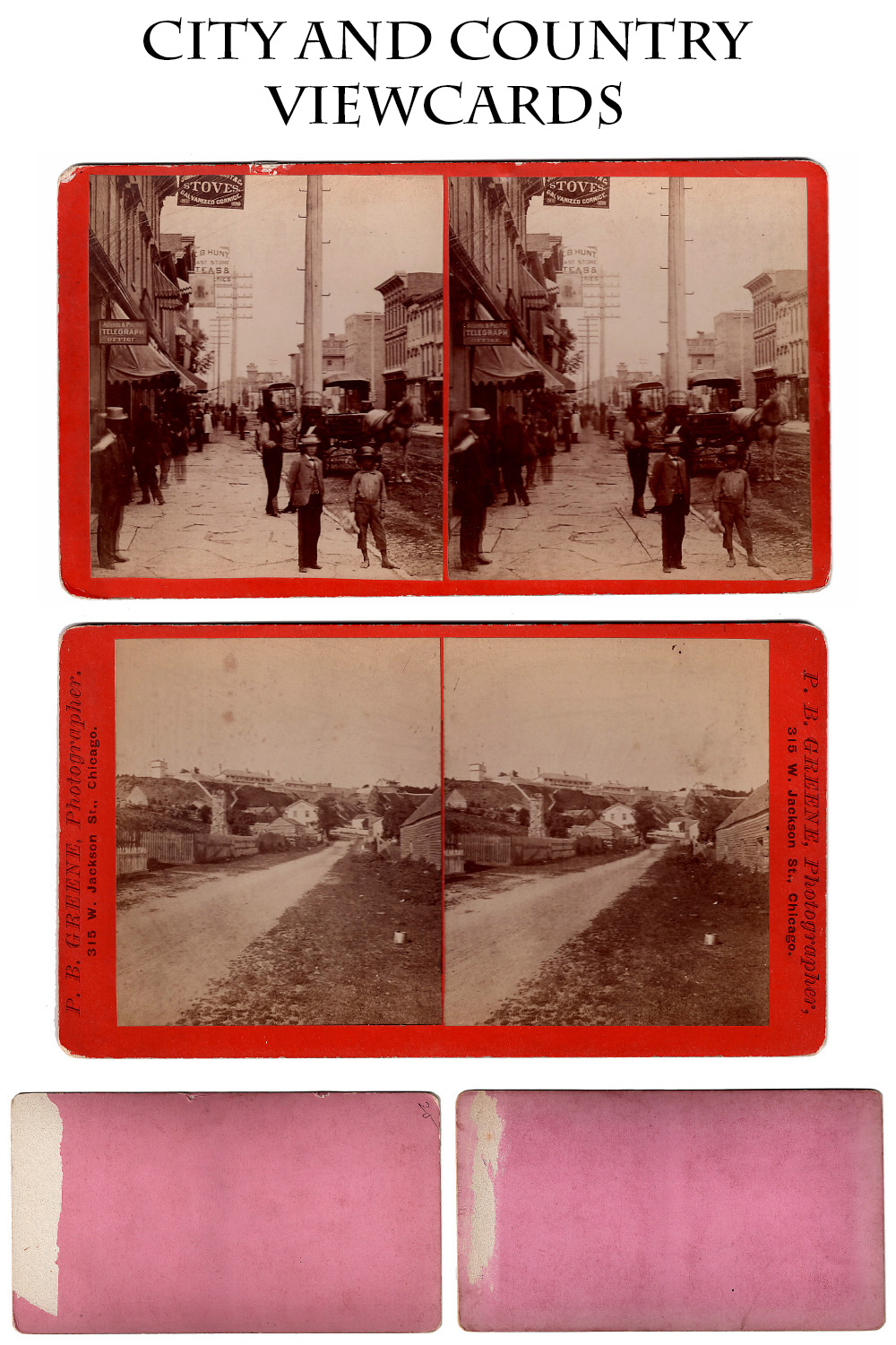
15-04-32A … Street Scene Stereoview, Possibly Chicago …
Urban street scene about 1900, orange mount, sepia tone. An interesting view showing a city in transition. A sign for a company selling stoves hangs down from above and the Atlantic and Pacific Telegraph office sign is visible at left. Horsedrawn vehicles are lined up in the dirt street, and people are scattered along the sidewalk to the rear. The real novelty, however, are the large telephone poles lined up along the road and receding into the distance, that form a nice contrast with the sign for the telegraph office and give a real feeling of the modern world intruding on and overwhelming the past. What a wonderful slice of urban life a century ago
… $45.00 SOLD
15-04-32B … Fort Mackinac / Mackinac Island Michigan …
The second view is by Greene of Chicago, taken on Mackinac Island, Michigan showing the street leading up to the fort, which looms above. Mackinac played a serious military role on the northern frontier from the wild Indian frontier days of the 18th Century through the War of 1812. The British built the fort there during the Revolutionary War, and two battles were fought on the island during the War of 1812 when the US held the island. The fort remained an active US Army post through the late 1800s. As the military importance of the island faded it transitioned to a resort community for wealthy vacationers from Chicago and Detroit. Views of Mackinac are highly sought and quite scarce
… $125.00 SOLD
Click Here to E-mail Us!
Call us @ 419-842-1863

15-04-33 … My Angeline and Flip Flap Militia Viewcards …
Two Rural Black Life Genre Stereoviews ca. 1898. Stereoview companies issued thousands of cards for viewing in the parlor as entertainment before the days of radio and television- everything from travel photos to genre scenes of different cultures and satirical sequences. Here are two dealing with Black life in America with plenty of fuel for social commentary. The first is a Keystone view copyrighted 1898 captioned “My Angeline” showing two young black children barefoot, dressed in rags and next to a decrepit clapboard building with trash on the ground. They are obviously meant to be cute in imitating adult sweethearts, but the view is also resonant with contrasts of rural poverty versus city sophistication in the young man’s use of a stick in place of a cane, and obvious implications of attempted imitations of white society that are meant to be comic or amusing.
The second is by the Littleton View Company out of New Hampshire captioned the “flip-flap militia.” About a dozen young black children pose in a semicircle with wooden guns at support arms while a taller young man with his back partially to the camera plays the part of an officer addressing them. While these were often marketed as southern views, the photographer’s location and the background suggest it was taken in New Hampshire. An interesting pair of African American views with the usual racist overtones of the period
… $95.00 SOLD
Click Here to E-mail Us!
Call us @ 419-842-1863
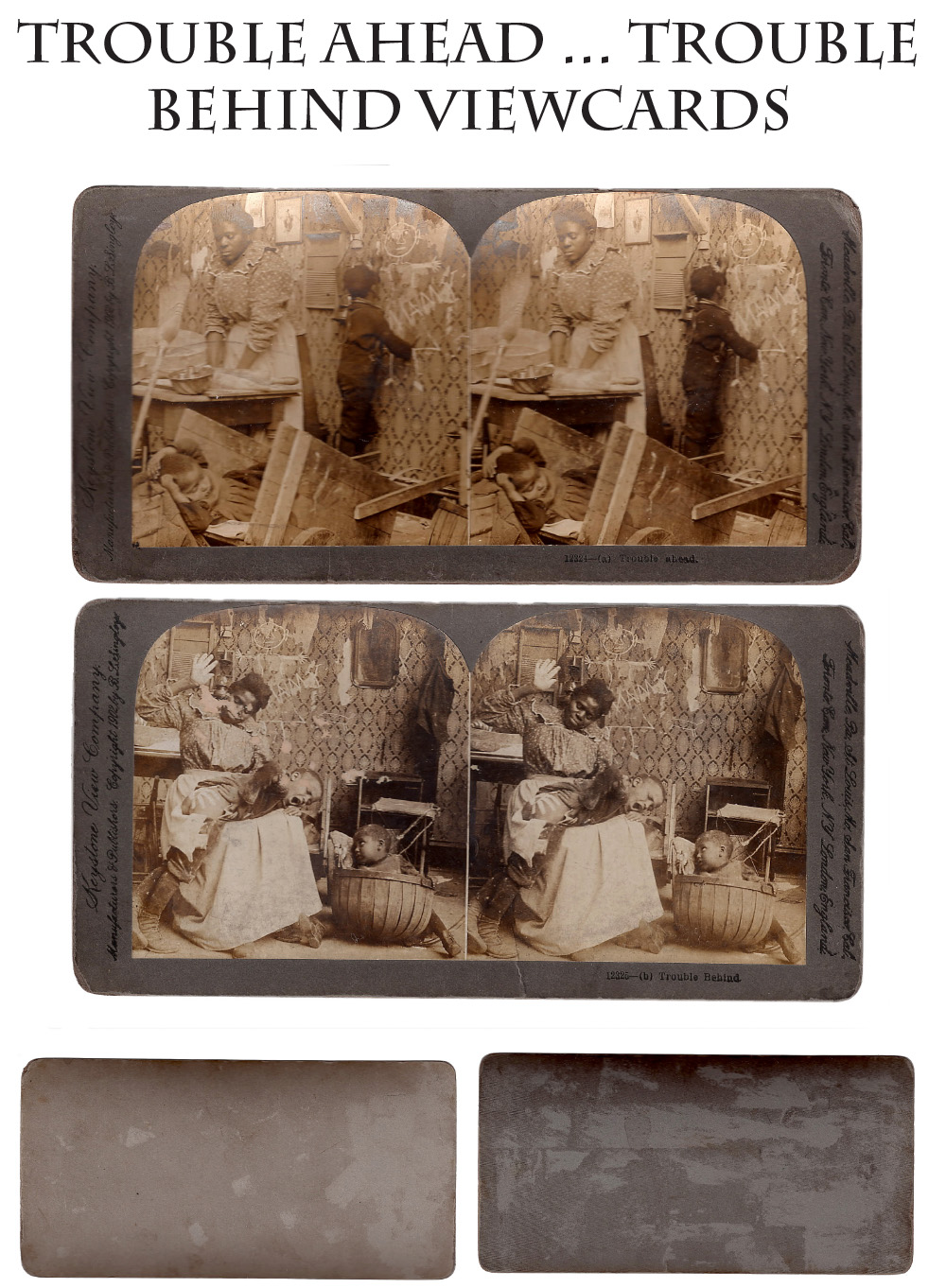
15-04-34 … Keystone Stereoviews 1902 “Trouble Ahead” and “Trouble Behind.” …
Pair of Keystone stereos meant to be viewed sequentially. In contrast to the above pair that seem to be country views, this sequence looks like it is in an urban tenement, though we do see a small wheel barrow and a splint basket. In the first a plump, young black woman tries to roll out dough while a baby sleeps in a make-do cradle made from a small wheel barrow while her young son creates mischief behind her by drawing a likeness of her on the wall and labeling it “Mamy”.
The second view shows the result when she discovers his art work: he’s getting a spanking marked by the flour imprint of her hand on his rear while baby brother or sister, now transferred to a basket looks on. Sepia tones, good clarity. The second view has a slight crease in the mount lower margin that does not affect the image, and her face and raised shoulder show slight emulsion damage in the left view of the image. For the pair
… $95.00 SOLD
Click Here to E-mail Us!
Call us @ 419-842-1863

15-04-35 … Allen & Wheelock Center Hammer Army Revolver …
I love the mechanical ingenuity shown in revolvers of the CW period, and these Allen & Wheelock revolvers are among the most interesting designs of the period. Only about 700 of these .44 Caliber revolvers were made by Allen and Wheelock in 1861-1862, but extant examples indicate the number was likely greater. They seem to be batch numbered rather than serial numbered throughout the model (this one is numbered 146,) so there is little to go on there. The 2nd and 3rd Michigan Cavalry probably got this pattern, and other units likely carried them as well. Anyway, it’s a clever design. The hammer is not only center hung, but the trigger guard releases to act as the loading lever for the rammer. Barrel shows a mix of brown and grey, some crustiness but no pitting. The frame and cylinder are similarly colored, with more brown and some silver/gray peeking out on the forward part. The hammer shows some faded case. Grips are tight and very good, just a drip of red paint on the left side that will probably come off. A tight example of a fairly scarce issue revolver. Worn and about VG overall
… $1,495.00 SOLD
Click Here to E-mail Us!
Call us @ 419-842-1863

15-04-36 … Watertown Arsenal 1864 Dated Infantry Belt …
Watertown Arsenal was one of the few producers of accouterments to actually date their products and thus have always been a favorite among collectors. Here is a very nice condition “waxed leather” belt clearly marked on the outside of the belt about half way around: Watertown / Arsenal/ 1864. These belts were meant to imitate buff leather by turning the leather rough-side out, so the smooth finish is on the interior of the belt. Both buckle and flat C-clasp keeper are present. The buckle has the correct beveled arrowhead hooks and contoured fastening hook. A very solid rig that would go well with other Watertown made accouterments … d
… $475.00 SOLD
Click Here to E-mail Us!
Call us @ 419-842-1863

15-04-37 … Fighting Knife made from a French Cavalry Saber …
I have handled a number of US Civil War cavalry sabers cut down to fighting knives for presentation to soldiers going overseas in World War 2. This is the first example I’ve had of a French saber so altered. The arsenal marks are still present on the spine indicating it was made at the Chatellerault Armory. No year is visible, but the blade mark suggests about 1850. The guard was ground down, leaving just the collar of brass and the brass pommel cap. The leather and wire of the grip were removed, but the wood is the original and shows the inletting for the knuckleguard. Blade is gray with dark spots..The blade was crudely ground down, giving the fuller very uneven edges, but the inspector cartouches are visible and there is no real damage done after the alteration. I had one of these once that was sent to a young man in the Pacific theatre having been carried by his ancestor in the Civil War. There might be such a story that was attached to this as well. A cool twice used combat blade … ej-17067
… $135.00 SOLD
Click Here to E-mail Us!
Call us @ 419-842-1863
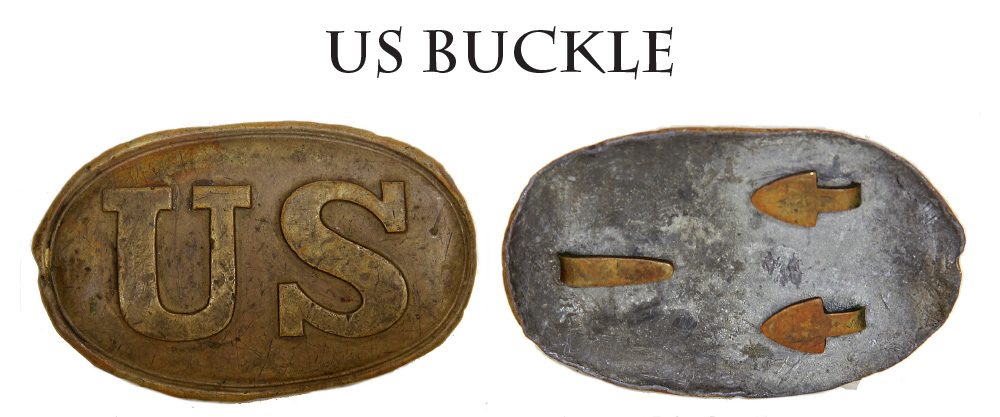
15-04-38 … Standard Issue US Oval Belt Buckle …
The regulation waist belt plate worn by Union infantrymen. Overall good to VG with some denting on the edges. Has arrow hooks and flat prong. There are at least two patterns of US buckle that utilize a flat prong on the back as opposed to the more prevalent beveled prong… and this is one of them. The most common flat prong example has the Boyd & Sons style face with no maker’s mark. A good solid CW buckle
… $225.00 SOLD
Click Here to E-mail Us!
Call us @ 419-842-1863
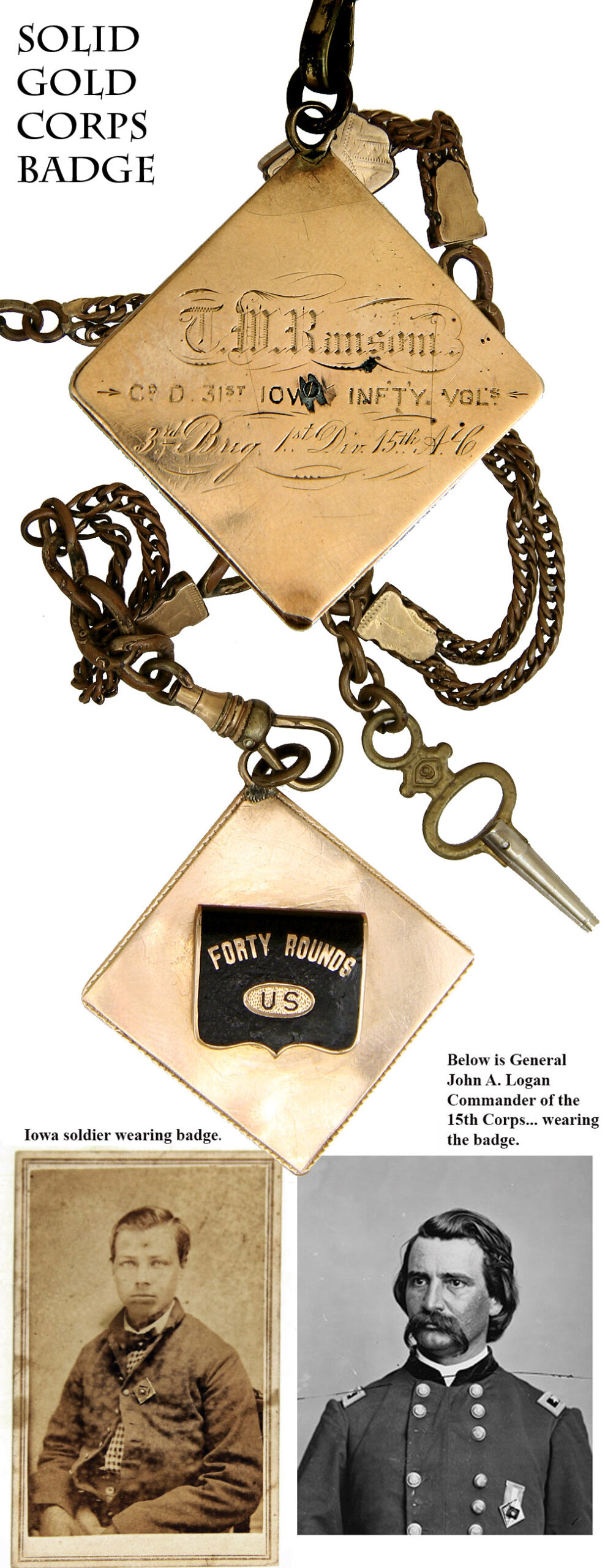
15-04-39 … Wonderful Solid Gold “FORTY ROUNDS” Identified Fifteenth Corps Badge …
The badge of the 15th Army Corps is well known among collectors for its no-nonsense approach to things: a cartridge box with an oval US plate on it and the motto “forty rounds,”. The “40 Rounds” referencing a cartridge box’s full load of ammunition, which was four packs of ten cartridges each. These 15th Corps guys were ready for a fight.This is a magnificent jeweler made wartime specimen done entirely in gold and carried by the soldier on his watch chain. Beautifully engraved on the reverse by a talented jeweler: ”T.W. Ransom / Co. D 31st Iowa Inf’t’y Vol’s. / 3rd Brig 1st Div. 15thA.C.” They don’t get much nicer! The face of the badge features the enameled cartridge box with its plate and motto centered in a plain gold field on a diamond with delicately engraved border and suspension loop at top. At some point the cartridge box, which is separately made and then attached to the diamond shaped backing, came off, likely from handling on the watch chain, and was reattached using a small screw from the rear, which unfortunately took off the “A” in “Iowa” in the inscribed regimental designation on the reverse. The soldier obviously cherished this piece of gold even after the war as it is currently attached to his watch chain from the later Victorian era. The chain even preserves his watch key! Theodore D.W. Ransom was from Fon Du Lac, Wisconsin, but enlisted at age 18 in the 31st Iowa on 10/20/62 and mustered into Co. D of the 31st Iowa on 10/30/62, He mustered out on 6/27/65 at Louisville, KY. The regiment first saw service in Arkansas and Mississippi, and eventually was made part of the 15th Corps from January, 1863, until its muster out, losing 1 officer and 27 enlisted men killed or mortally wounded during its service, which included more action in Mississippi, Alabama, and Tennessee under Sherman. It suffered casualties at Arkansas Post, Vicksburg, Lookout Mountain, Missionary Ridge, Ringgold, Resaca, Dallas, Kennesaw Mountain and Atlanta, Savannah and finally at Bentonville, after which it took part in the Grand Review and later mustered out with 370 of the original 970 men it had taken into service in the fall of 1862. Ransom must have been very proud of his service and the badge shows it. About as fancy as a corps badge gets … medal is 1-3/4″ in size measured diagonally … chain is adjustable in length, measuring over 12″ overall length
… $2,450.00
Click Here to E-mail Us!
Call us @ 419-842-1863
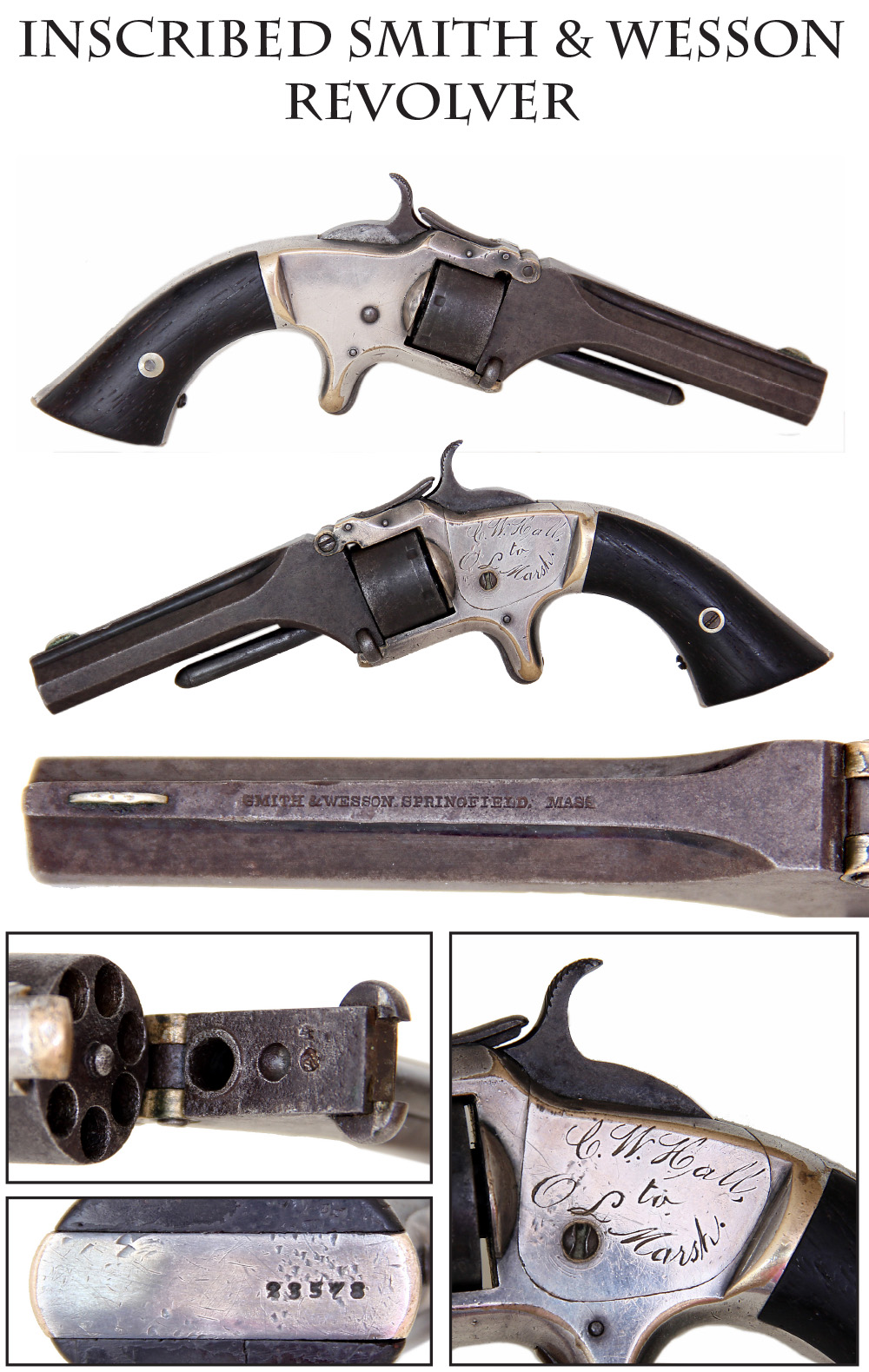
15-04-40 … Inscribed Smith & Wesson No. 1 Revolver … C.W. Hall to O.L. Marsh …
Fine little S&W 22 caliber revolver from the mid 1860s. About fine condition with interesting inscription. I will let you sort through the various data bases, genealogical sites, and census records to see if you can find the connection between the two people named on the revolver. Cool early example sn 23578
… $395.00 SOLD
Click Here to E-mail Us!
Call us @ 419-842-1863
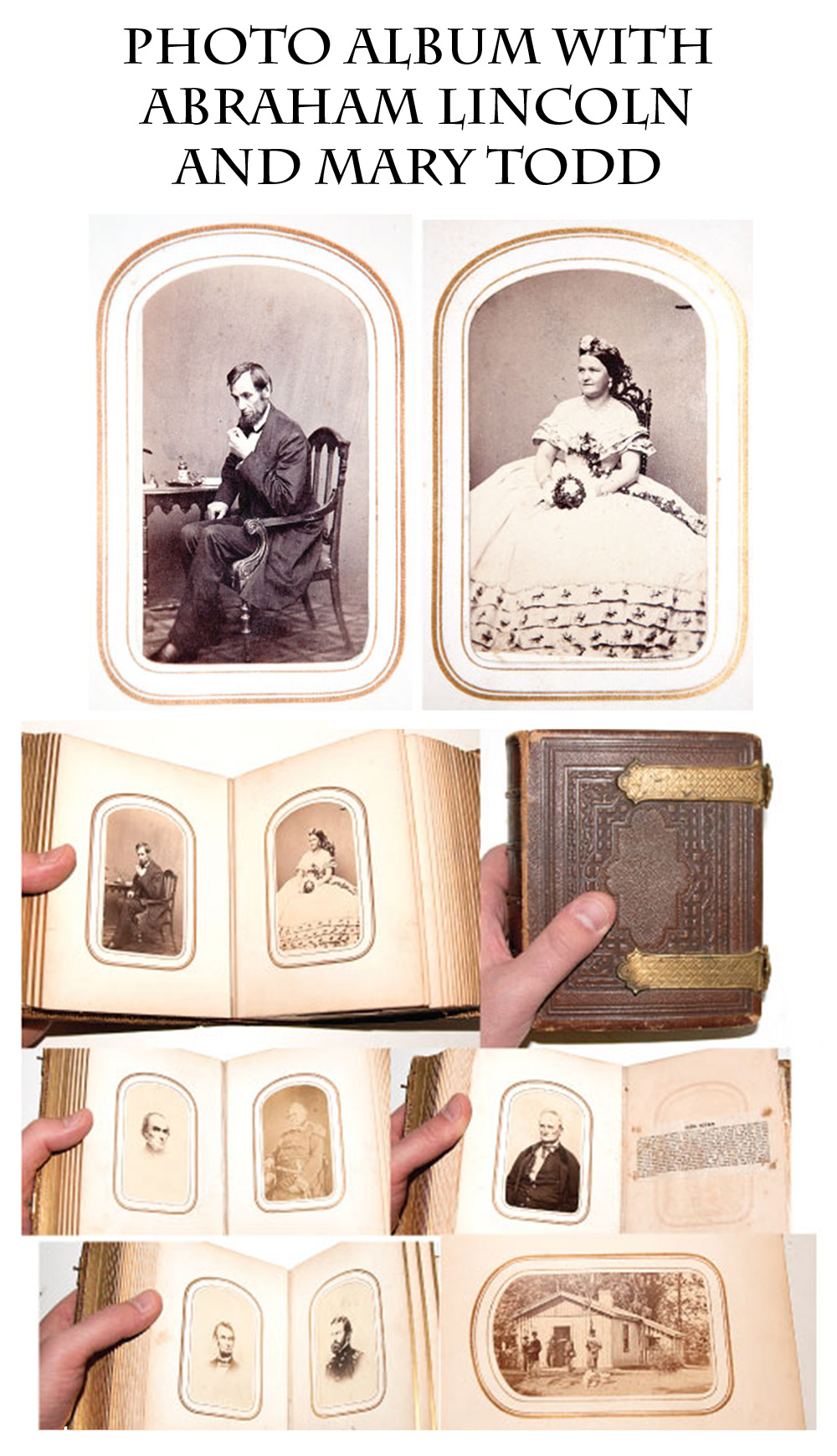
15-04-41 … Magnificent Lincoln & Mary Todd From Life Large CDV Album:
A treasure I purchased fresh from the family estate auction of Lieut. William W. McCracken 20th Ohio Volunteers… 1860s brass bound leather photo album for cartes de visites. The album is designed to hold fifty CDVs. Each page but three is full front and back and all the cartes are as new. The meat and potatoes found inside are the two MINT condition CDVs of the Lincolns. One shows Abraham Lincoln full seated leaning forward. The other shows Mary Todd Lincoln in as appealing a view of her as was taken. Each bears an Anthony / Brady back mark. Also present is an outdoor view showing soldiers posed around Grant s Petersburg Headquarters building after it had been moved to Philadelphia at the end of the war. Another interesting view is one showing a European medal. And at the back of the album is a crisp autographed CDV of a War of 1812 soldier named John Hicks of New Jersey along with a separate printed biography on Mr. Hicks which tells of his service in three wars. (1812, Mexican, and Civil). There is also a seated CDV photo of Professor Samuel F.B. Morse inventor of the telegraph — shown in the photo with him is an electric device but it does not look like a telegraph key. Other cartes include a from life Winfield Scott. Mass produced views of Henry Clay, Lincoln in bust, and Grant in bust, and Anna Dickinson. Also present is a retouched outdoor view of the Union League House in Philadelphia. There are seven CDVs of paintings or statues Christian in nature. There are a number of American cartes showing artwork of American scenes including one neat one of a mother playing soldier with her two kids in patriotic garb, another of a painting showing a little boy showing a little girl to play the flute, Washington kneeling before Martha, dozens of American views of lithos and paintings of 1860s life, a couple views of statues, and more. The album is beautiful though the front cover is beginning to separate. One of the nicest Civil War albums I have found in recent years, and this one is as found untouched and unaltered like the old days … and again Lincoln and Mrs. from life and mint
… $1,850.00
Click Here to E-mail Us!
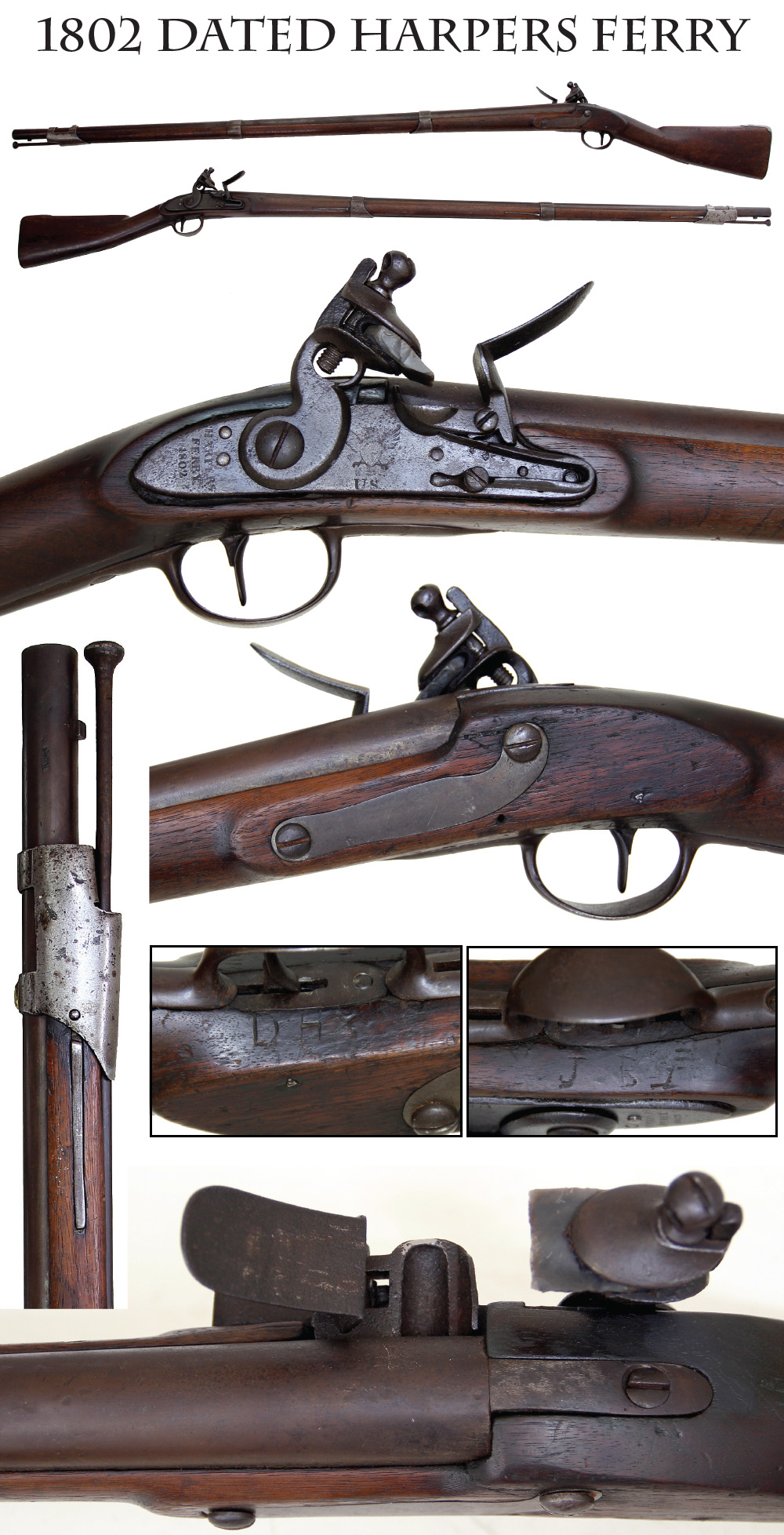
15-04-42 … Harpers Ferry 1795 Musket with 1802 Dated Lock …
A friend recently discovered this neat old musket and we have been having fun studying it. It is a 1795 Harpers Ferry musket with some interesting features. The lock is a straight-forward and very scarce 1802 dated Harpers Ferry lock. Harpers Ferry and Springfield made their own versions of the Model 1795, and 1802 is the third year of production at Harpers Ferry. As anyone can tell, however, this musket had a larger lock in it at one point. The larger inletting is rather crudely done and easily seen The gun appears to be a Harpers Ferry, though the barrel MIGHT be from a French 1766 Charleville as it is marked only with a “V” on the top of the barrel near the pan. Harpers Ferry numbered their barrels in 1802. It measures the correct 44 inches and has a bottom-mounted bayonet stud which is proper for Charlevilles and for 1802 and earlier Harpers Ferry examples. The barrels were shortened to 42 inches soon after. The stock has the sturdier lower comb stock without shallow flutes, another accepted Harpers Ferry feature, though possibly a later HF production feature. (Flayderman says Harpers Ferry never had the flutes; Moller says they did early-on, but phased them out by 1809.) The lock does not have a prominent rear tip, again proper. Moller says some did not have the tip until 1803. There is a faint trace of serial number on the buttplate tang,ending in 113. Moller states HF butt plates are numbered through 1803. When my friend found this the barrel and stock tip had been cropped a half inch and he had this professionally restored using an original piece of antique barrel. This is a pleasing 1795 HF musket in original flintlock configuration, The wood shows some dark areas, and two sets of initials carved on either side of the triggerguard, but aside from normal handling marks is very good. The barrel is a very pleasing, even plum brown. The upper band shows somewhat bright with dark spots; the middle and lower bands a more muted gray. Swivels are missing and the lug in front of the triggerguard is gone. Button-head ramrod in place, band springs, etc. Lock is functional but the pan does not center on the vent-hole … not surprising since the gun obviously has had a least one other lock installed in its history. A neat old gun
… $3,850.00
Click Here to E-mail Us!
Call us @ 419-842-1863
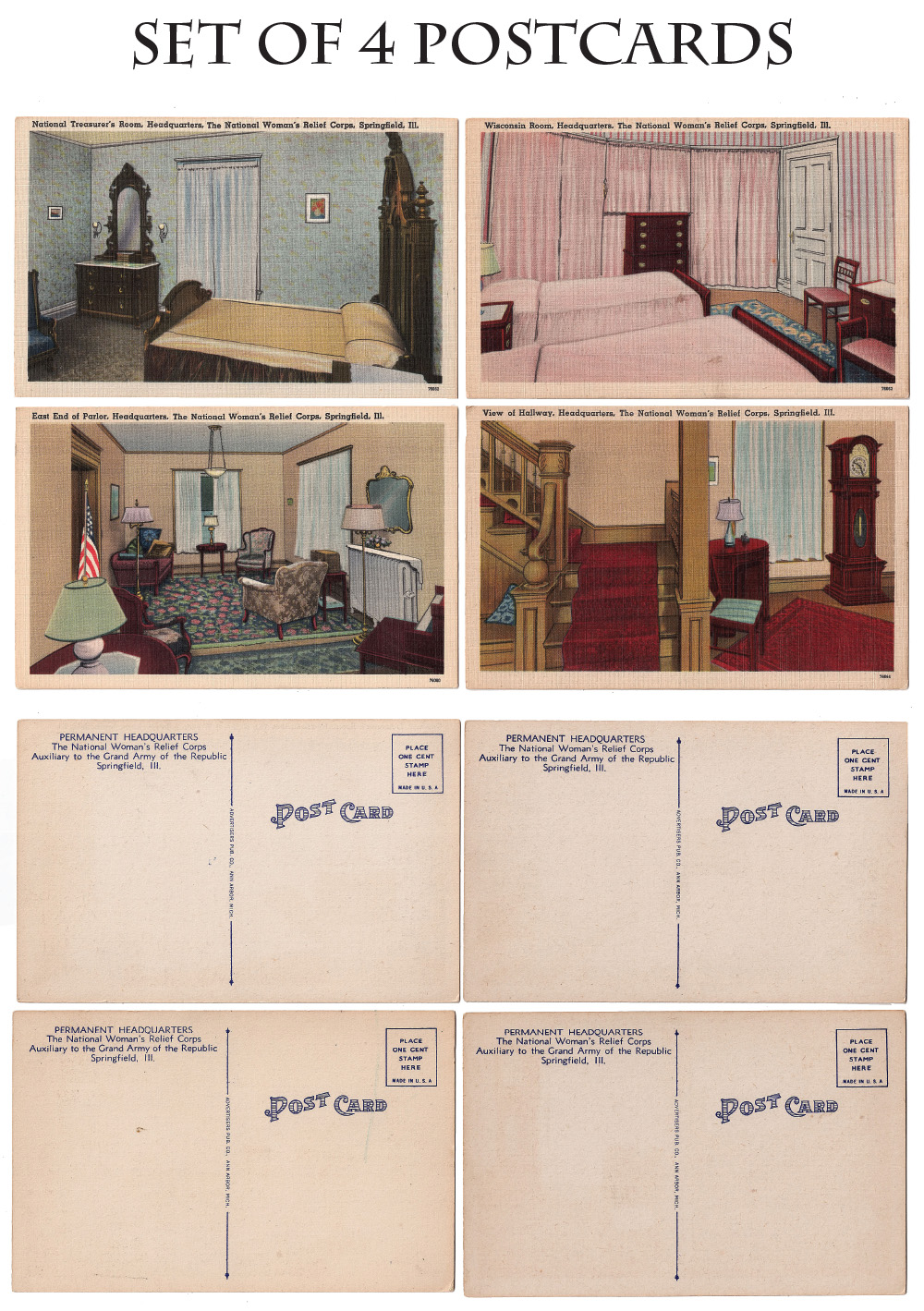
15-04-43 … Four Postcards of the Headquarters of the National Women’s Relief Corps …
The WRC was an auxiliary to the GAR, helping the veterans but possessing their own organization. Here are four colored postcard of the early twentieth century showing rooms in their “Permanent Headquarters” in Springfield, Illinois. A nice add-on to a collection of GAR and veteran pieces. Very affordable Civil War collectibles
… $15.00 SOLD
Click Here to E-mail Us!
Call us @ 419-842-1863
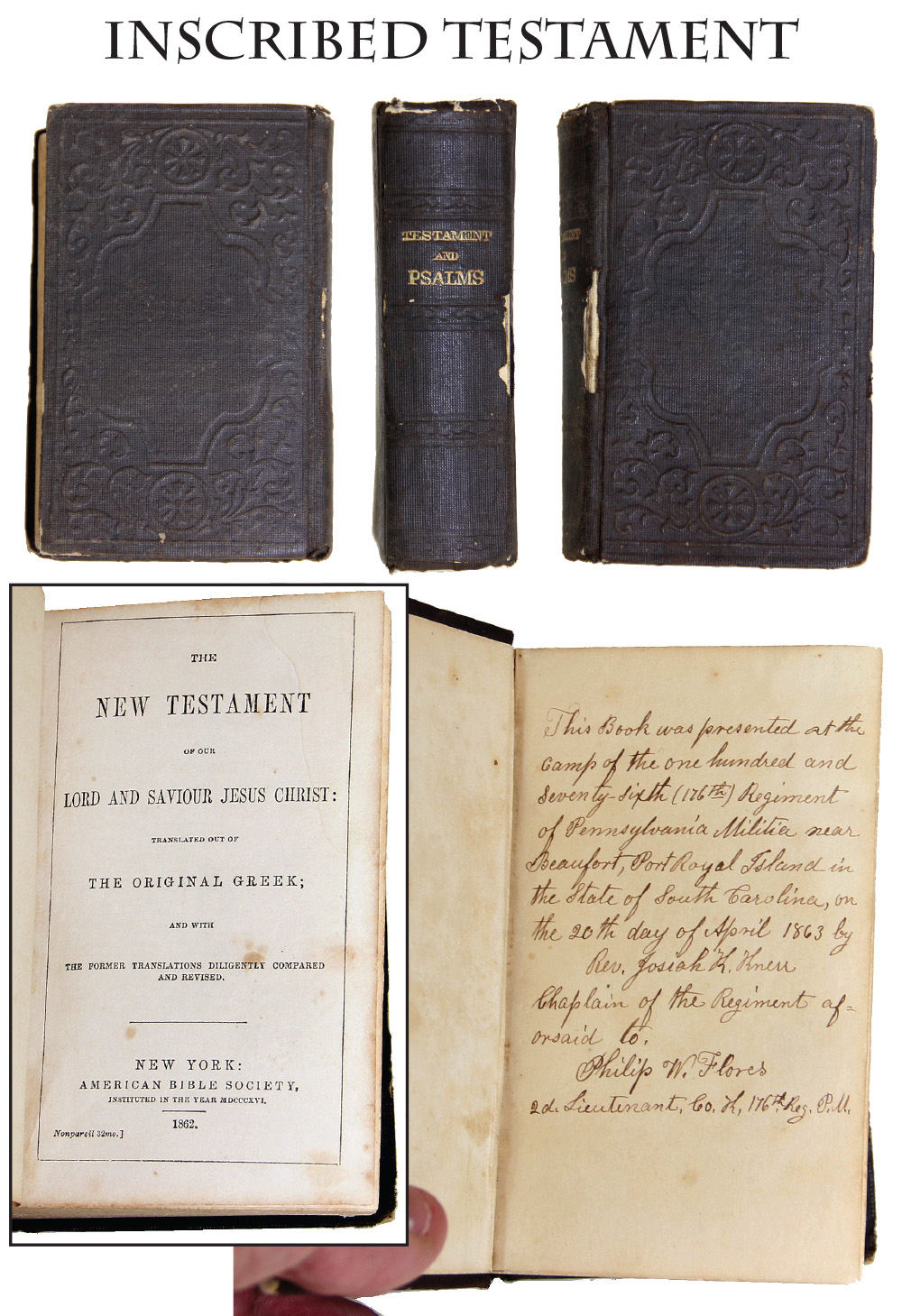
15-04-44 … Presentation New Testament From The Chaplain of the 176th Pennsylvania To One Of The Officers / Both Men From Allentown, Pa. …
Identified pocket Bibles and Testaments are neat personal items of Civil War soldiers. This one has a great inscription: “This book was presented at the camp of the one hundred and seventy-sixth (176th) Regiment of Pennsylvania Militia near Beaufort, Port Royal Island in the State of South Carolina, on the 20th day of April 1863 by Rev. Josiah K. Knerr Chaplain of the Regiment aforesaid to Philip W. Flores 2d Lieutenant, Co. K, 176th Reg. P.M.” (This is one of the better and lengthier inscriptions I have seen inside a Bible or Testament.) The 176th was a nine-month outfit, one of the regiments of “drafted militia,”, It was mustered in at Philadelphia in November, 1862, and served in the 7th Corps at Suffolk, Virginia. It then shipped out to the Department of North Carolina and Department of the South, where it served under Gen. Foster at New Berne and Charleston, doing guard and picket duty until muster out in August, 1863. Philip Wetzel Flores (1832-1908) enlisted 11/7/62 and mustered in the same day as First Sergeant of Co. K of the 176th PA. He was promoted Second Lieutenant on 12/6/62 and was mustered out 8/18/63. Flores may have known Chaplain Knerr previously, they both had an Allentown, PA., connection. After the war Flores worked for Internal Revenue, but was prominent in local history work, helping found the Lehigh County Historical Society. Josiah Knerr (1840-1917) must have been an interesting character: he enlisted as a common private and mustered into Co. B on 11/7/62, but was then promoted to regimental Chaplain 3/3/63 and served in that capacity until muster out in August. He was a member of the United Evangelical Church and is buried in Allentown, Pa. A very fine piece of Christian Military Ephemera with world class inscription and interesting history
… $295.00 SOLD
Click Here to E-mail Us!
Call us @ 419-842-1863
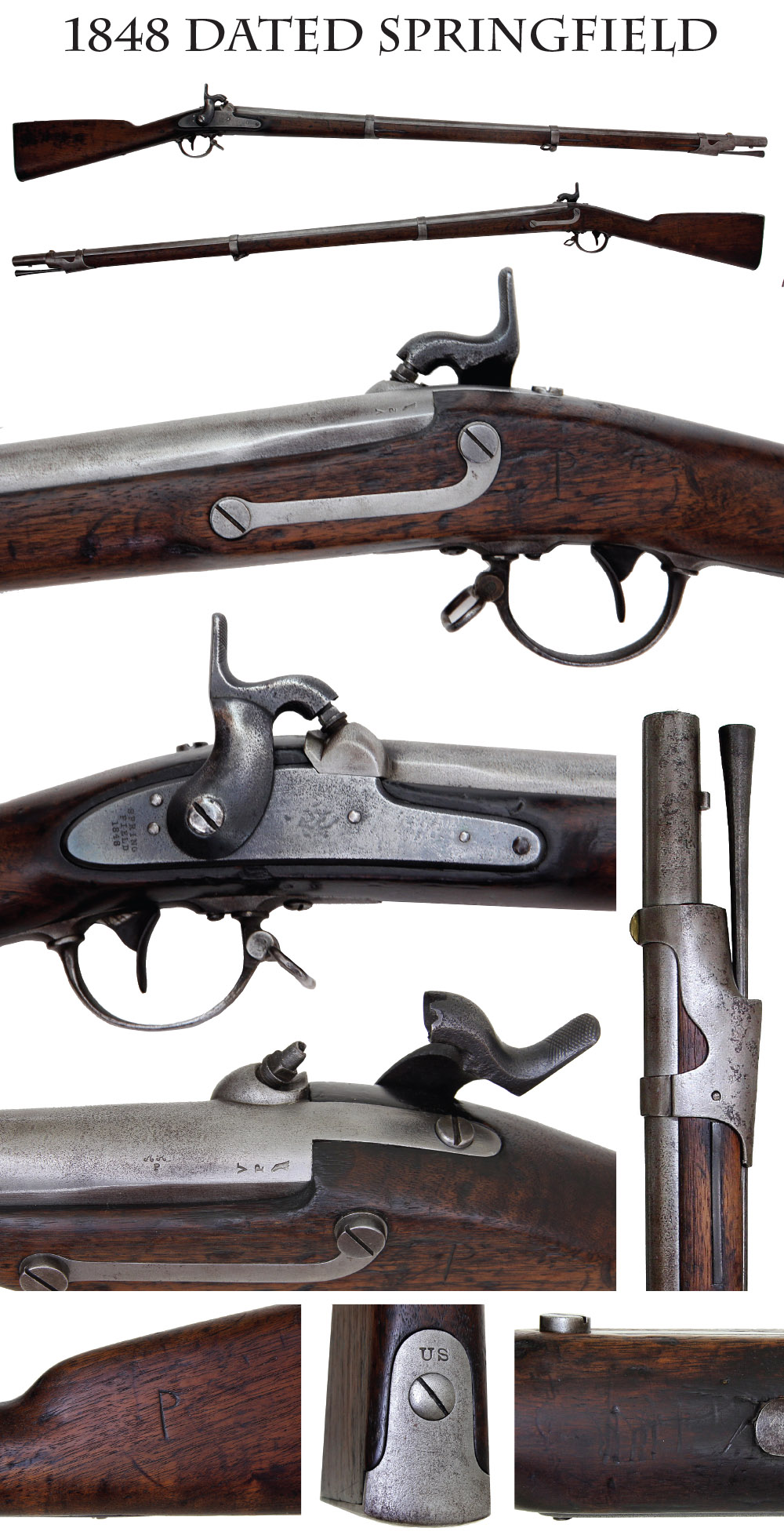
15-04-45 … US Model 1842 Springfield Musket …
The last of the .69 caliber U.S. muskets and the first of the percussion long arms for general issue to infantry, though still intended to spew out buck and ball rounds at the enemy. These are key pieces in US martial arms development. One innovation in the 1842 Pattern Percussion Musket was its use of fully interchangeable parts. Another was its production at both the Springfield and Harpers Ferry Armories. Here is an example with a Springfield 1848 dated lock and a Harpers Ferry Barrel. Overall VG condition. Most markings are clear. The eagle forward of the hammer is too light to make out, though the Springfield and 1848 date behind the hammer are sharp. The barrel has been gently cleaned to a light silvery gray and shows minute salt and peppering that is not obtrusive. There is deeper pitting at the muzzle forward of the nose band. Despite the cleaning the barrel shows clear V/P/eagle proofs at the left breach, and just forward of them the Harpers Ferry barrel proof of AR/P for Adam Ruhlman, who was inspecting barrels ca. 1850-52. Rod and swivels, all bands and front site and bayonet stud are in place, the hammer face shows a slight chip, as does the nipple, which sits a bit high and is certainly a replacement. The wood has mixed light brown and darker tones. No cartouches are visible, but a soldier or owner scratched a P into the butt stock and the side flat aft of the side plate. Edges show rounding from actually use, and the wood has numerous age dings as should be expected, but is solid, with no cracks or edge chipping. These guns saw a lot of use early in the Civil War in the hands of volunteers rushing to the battlefield on both sides …
hej
… $1,075.00
Click Here to E-mail Us!
Call us @ 419-842-1863
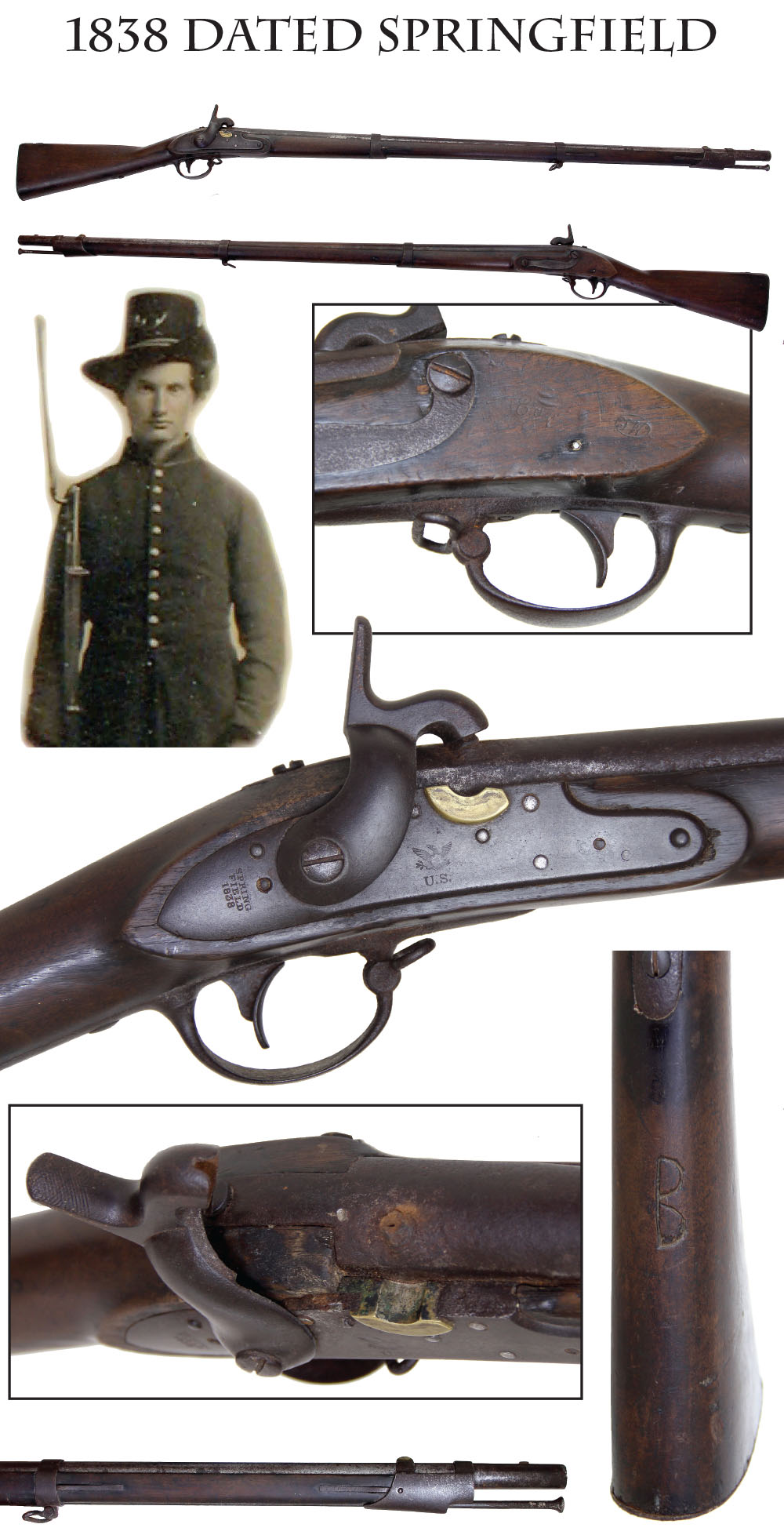
15-04-46 … Springfield M1816 Conversion Musket:
Typical Early Civil War musket used by both North & South with soldier’s initial carved in the stock “B” or “D over D”, behind trigger guard tang. This is an 1816 pattern musket smooth-bore .69 caliber, with a correct arsenal conversion to percussion using the “cone-in-barrel” or “Belgian” method of conversion. This was done from 1848-57. Of some interest is the fact that guns dated after 1832 were considered first class and prime candidates to be updated. Nice overall untouched condition. Smooth metal with undisturbed age brown patina, nice wood with just a few dings. The original 1838 date of manufacture is clearly stamped at the rear of the lock plate, as is “Spring Field”” and their eagle at front. Barrel markings are obliterated under deep rust brown patina. The inspector’s view mark (cartouche) on the wood opposite the lock is plainly visible. Swivels in place, correct original rod, front sight on top band, bayonet stud in place near muzzle. Mechanically excellent, 100% original 100% complete. These are the guns that fought the Civil War for the first couple of years until imports, arsenals and contractors could get up to speed. This is about as honest an 1816 as you could hope to find and priced very realistically at
… $850.00 SOLD
Click Here to E-mail Us!
Call us @ 419-842-1863
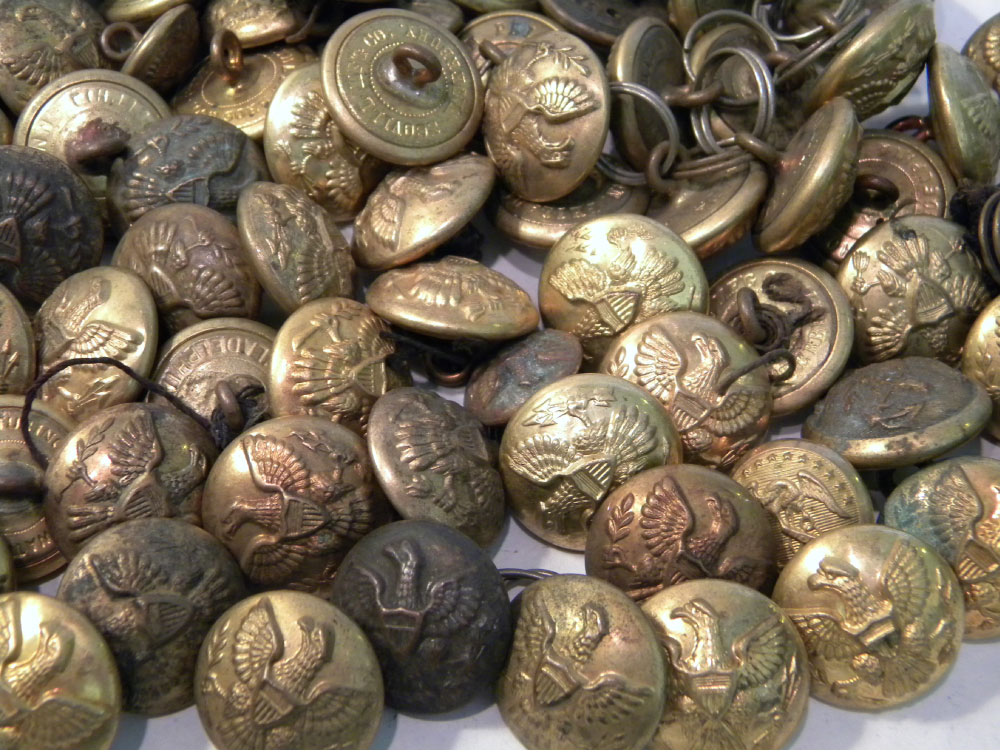
15-04-48 … A lot of TEN Original Indian War Large Size Eagle Coat Buttons.
A few years ago at an eastern Pennsylvania auction I bought a couple large bags full of these early Indian Fighters buttons and then I put them aside and forgot about them. I just stumbled across them again …. So here is a great opportunity…. ten original buttons for $25.00 These can be mailed inexpensively in a padded envelope.
… $25.00 for 10
Click Here to E-mail Us!
Call us @ 419-842-1863
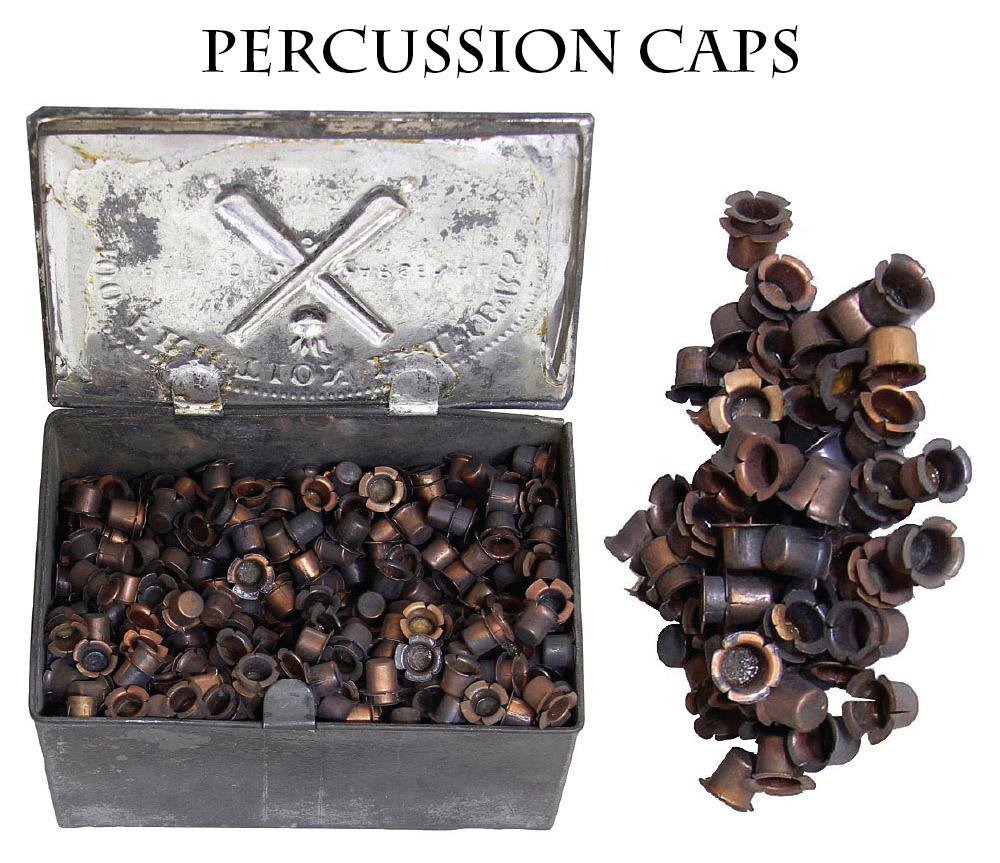
15-04-49 … Friction Primer Tin [Tin not for sale] and Percussion Caps …
I just purchased this neat old relic and am offering the percussion caps inside the tin in this offering. This very scarce tin came just as you see it, filled with percussion caps for muskets. The tin itself is the arsenal tin used to hold artillery friction primers. These are darned hard to find! I can only think of one instance where I found one still in a primer pouch! The tin has a hinged cover with small latch and embossed top reading: 100 FRICTION PRIMERS in an arc over an ordnance insignia, and FRANKFORD ARSENAL on either side. I don t know who put the percussion caps in the tin, it was certainly a handy storage idea, but since they do not belong together, I am splitting up the lot.
In each package of ten cartridges the soldier got 12 caps. While the supply lasts I will sell the percussion caps …
One Dozen … … … $15
Two Dozen … … … $25
Five dozen … … … $50
Click Here to E-mail Us!
Call us @ 419-842-1863
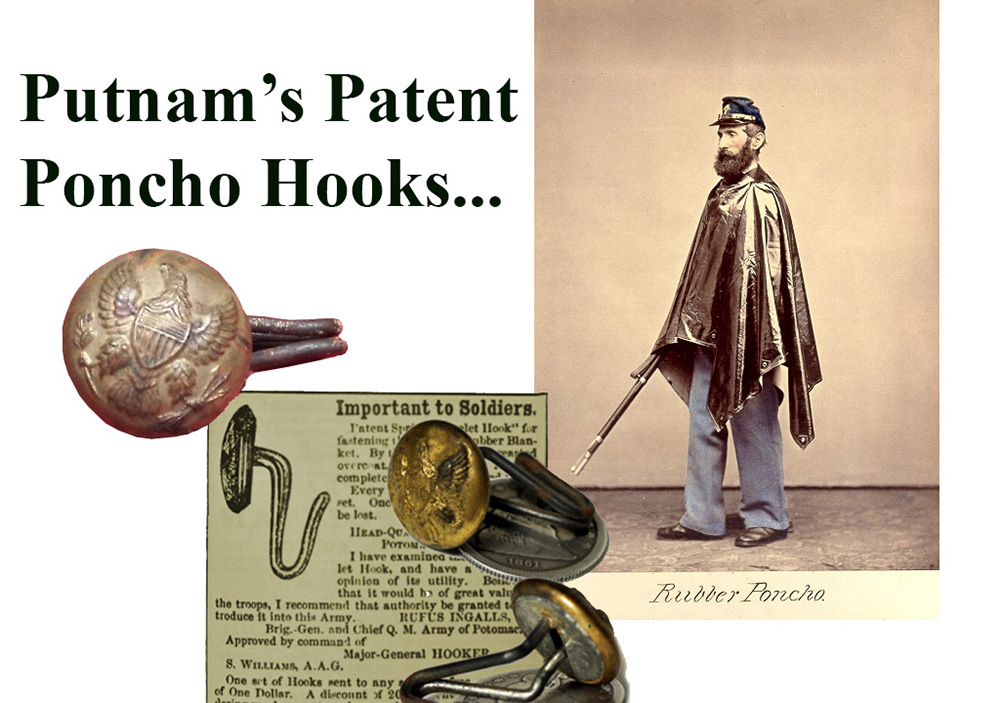
15-04-50 — LIMTED QUANTITY REMAINING — These buttons were patented in 1862 by Abel Putnam
and made with a long spring shank and were designed to go through the grommets on issue rubber blankets so the sides could be connect ed and the whole thing worn as a poncho in rainy weather.The face is a standard Union Army eagle button. The back is a spring hook fashioned from double spring steel wire. I have very few priced each at
… $45.00
Click Here to E-mail Us!
Call us @ 419-842-1863
Layaways are Welcome
Need to split your order into multiple payments? No problem! A simple 20% earnest money deposit will hold your item for you.-acf
You can then pay it off in easy installments that fit your budget.
Read Terms Here
Items to Sell? Contact Us
I am always interested in buying ANYTHING from the American Civil War… Guns, Swords, Civil War Muskets, Knives, Uniforms, Flags, Medals, Badges, Diaries, Letters, Autographs, Buttons, photographs, tintypes, daguerreotypes, Insignia, Camp Items, Battlefield Relics, canteens, Drums, Etc… Call 419-842-1863 and ask for Dave Taylor.

